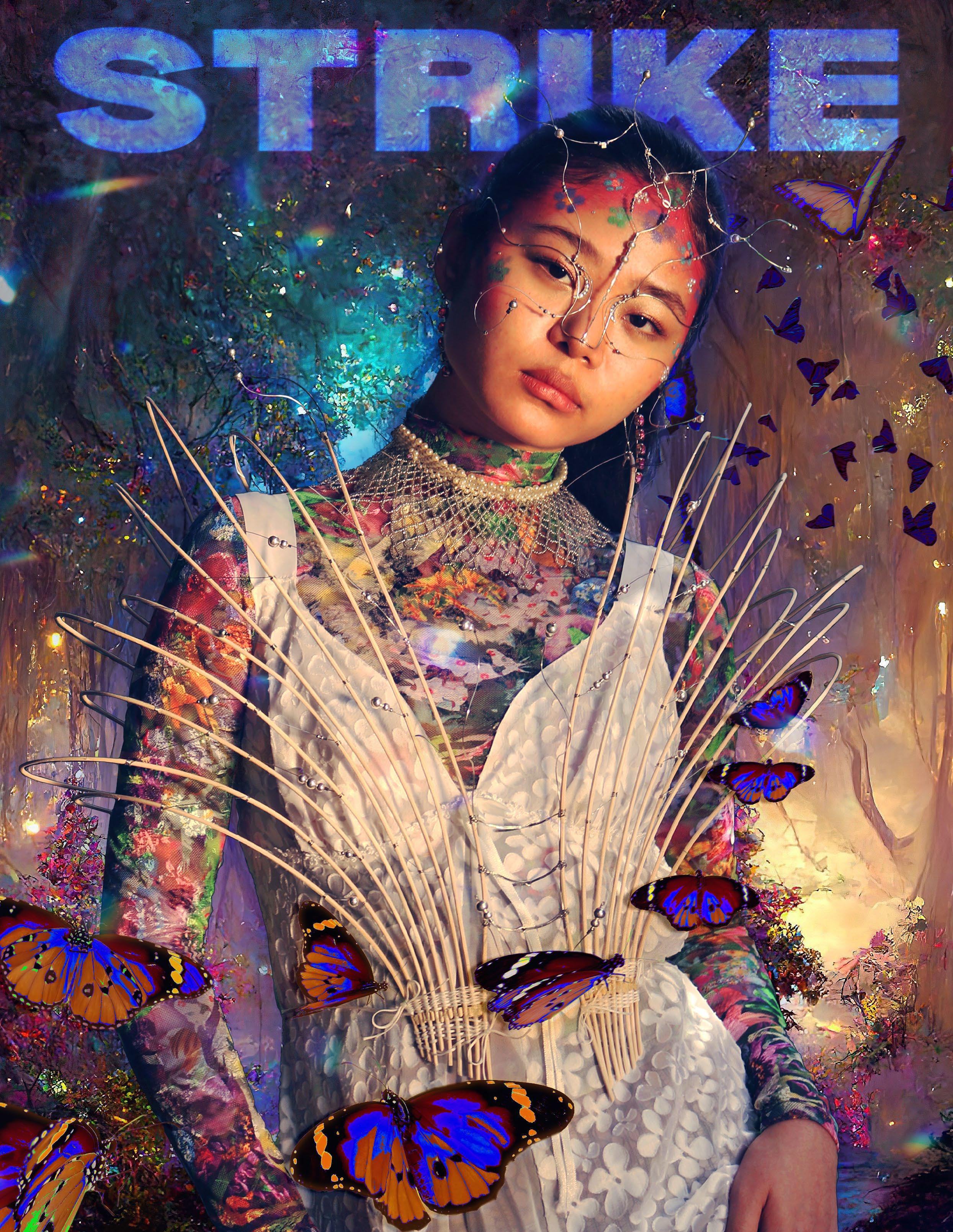


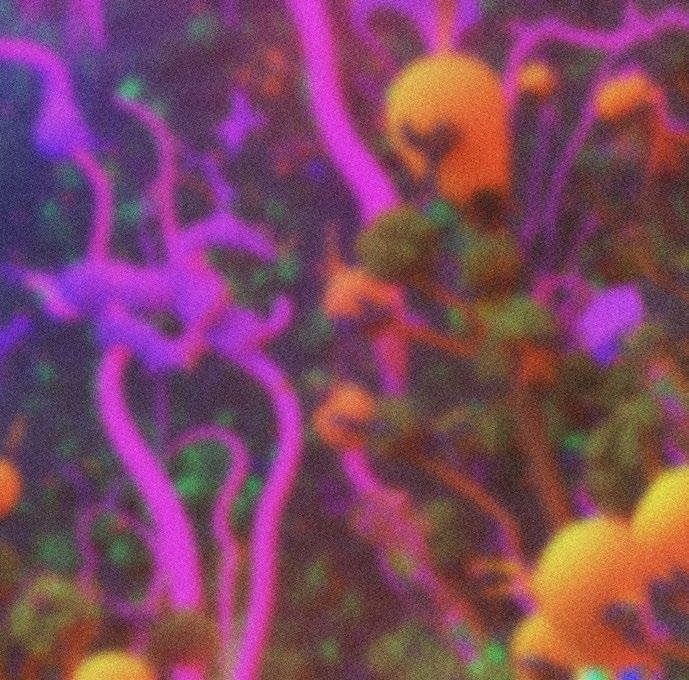







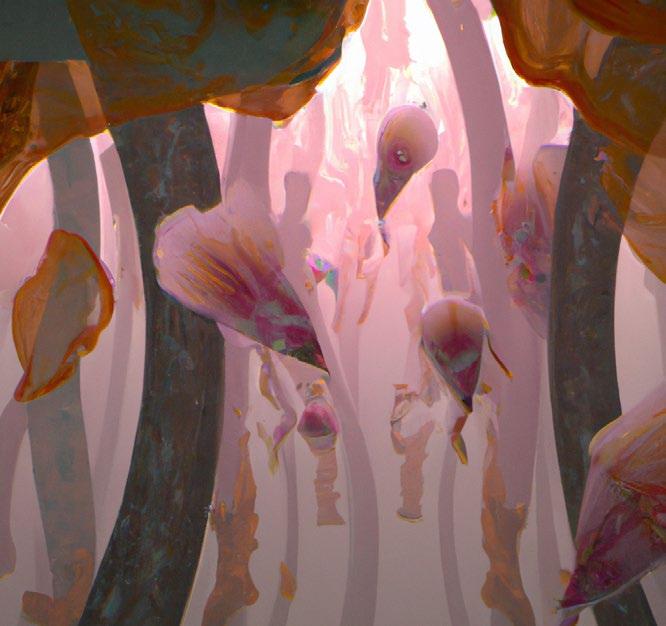
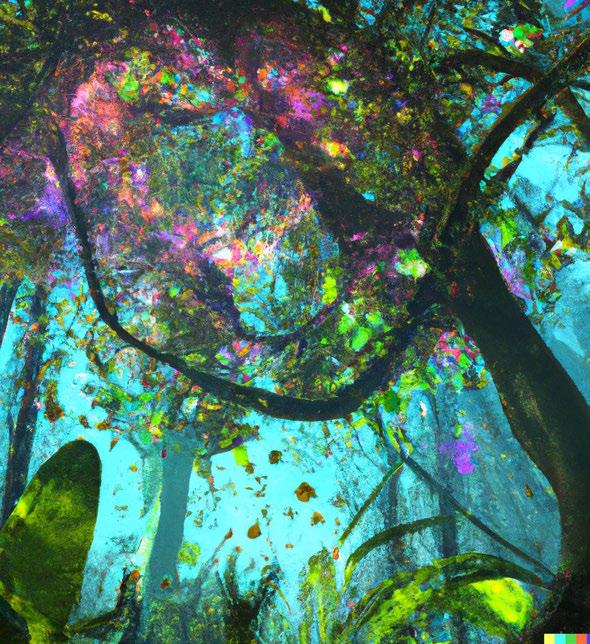
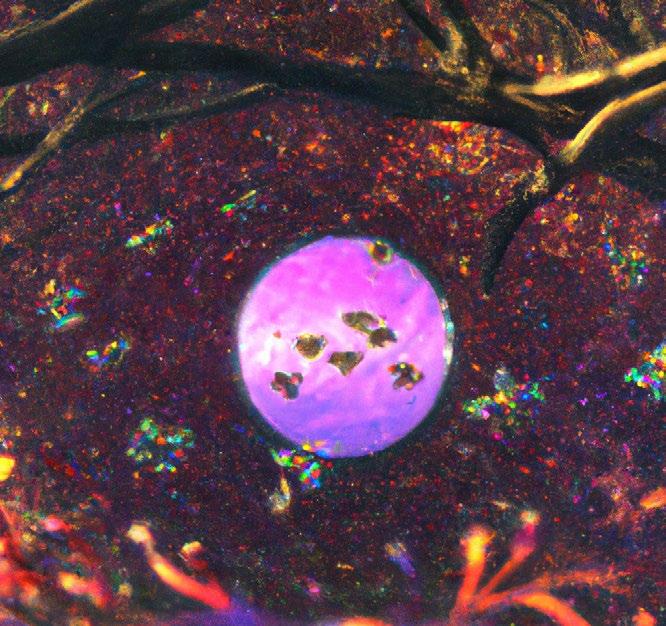


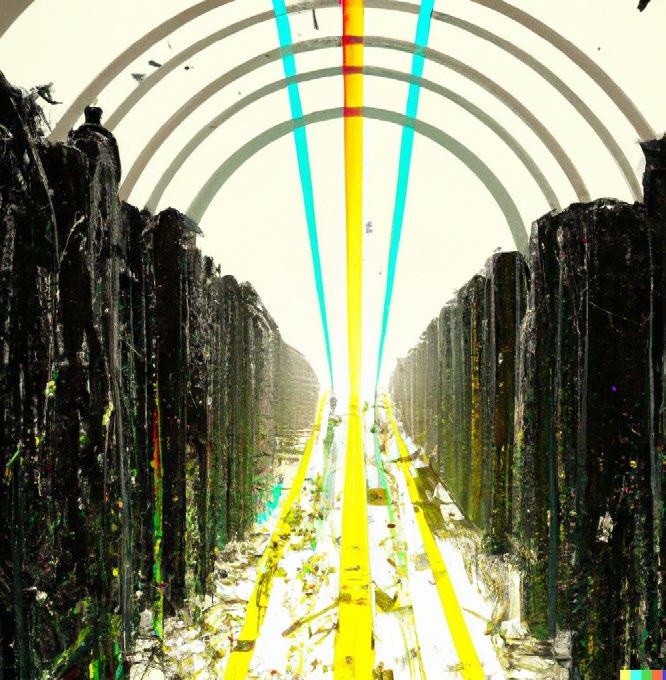
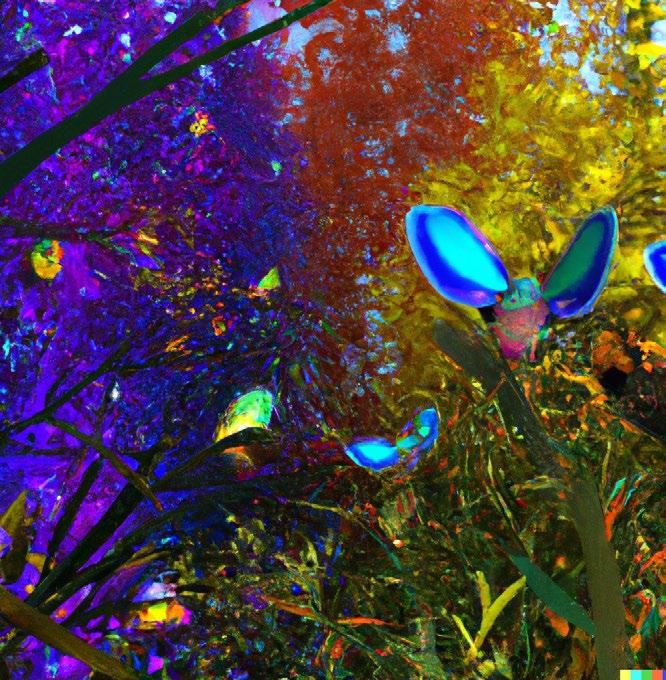
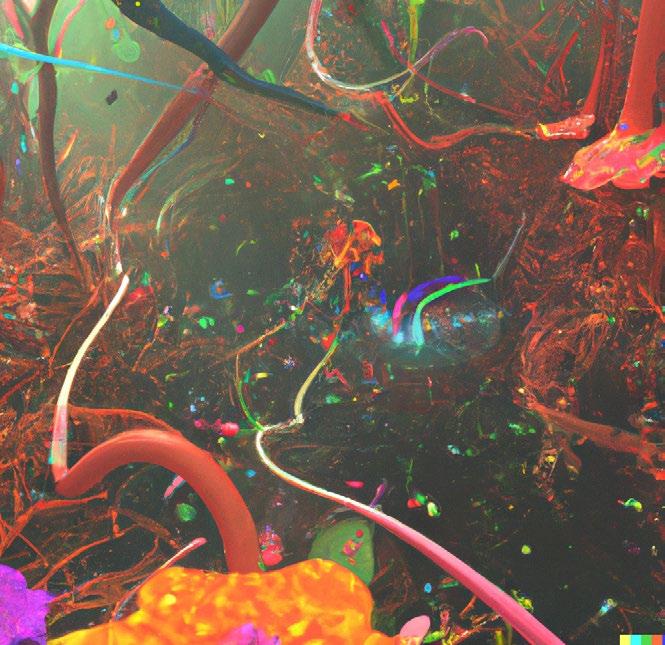

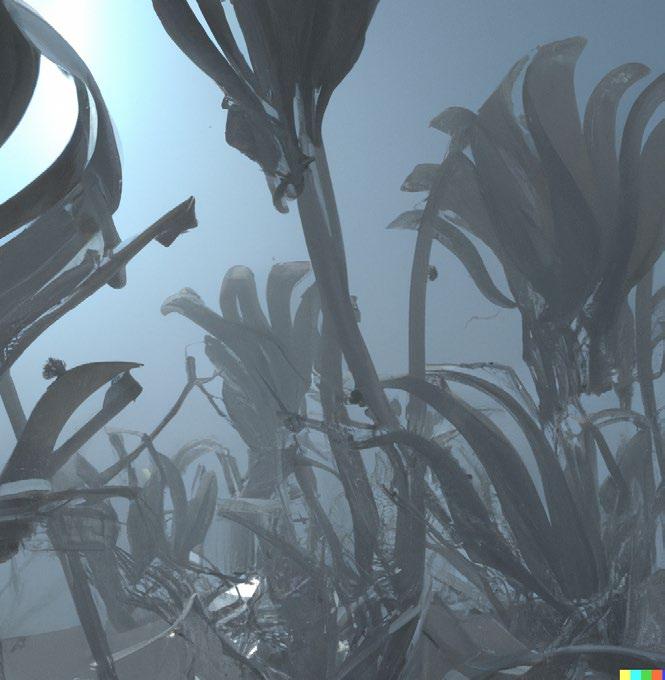
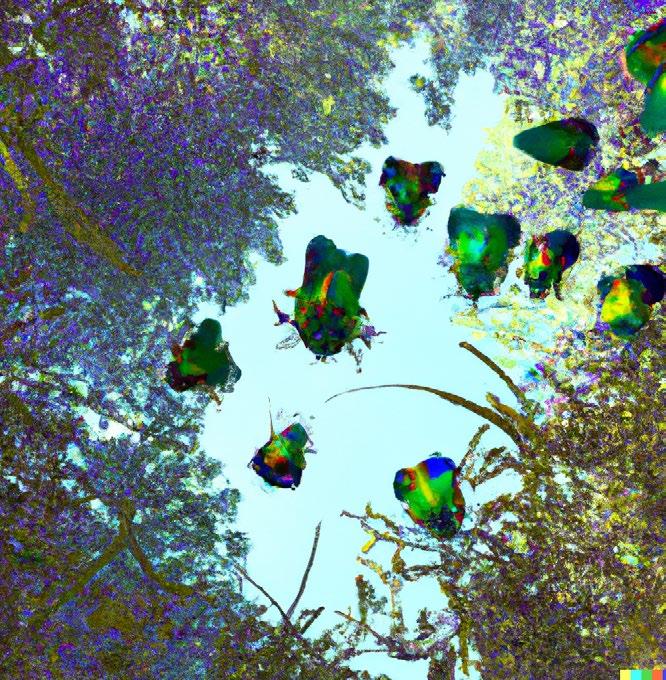

What could an apocalypse look like? generate
Rather than use this issue to critique human shortsightedness, we took “apocalypse” back to its roots. “Apocalypse” originates from the Greek word apokálypsis, meaning “revelation.” As we developed our creative concepts, apocalypse took on the form of a mass decluttering, a chance to live a simpler and more satisfying existence.
The idea of “apocalypse” extends beyond chaos and destruction; instead, it is a reimagination of empathy and a prioritization of desire. We bridged the gap between dystopianism and non-fiction, forcing our readers to question their conceptions of the near future.

This issue preys upon our shared anxieties, pushing back against idealistic rhetoric that purports to save what we have already destroyed. By asking ourselves What have we done? and Where are we going? we hope that these pages ignite a fire in the changemakers of our generation.
Thank you to my Strike family. I couldn’t have done it without you. I couldn’t be more grateful to be a part of this pivotal moment in Strike’s future.
For the last time, Strike Out,
Aliya Hollub Editor-in-Chief, Strike
St. Louis
5
Strike STL
Editor-in-Chief
Aliya Hollub
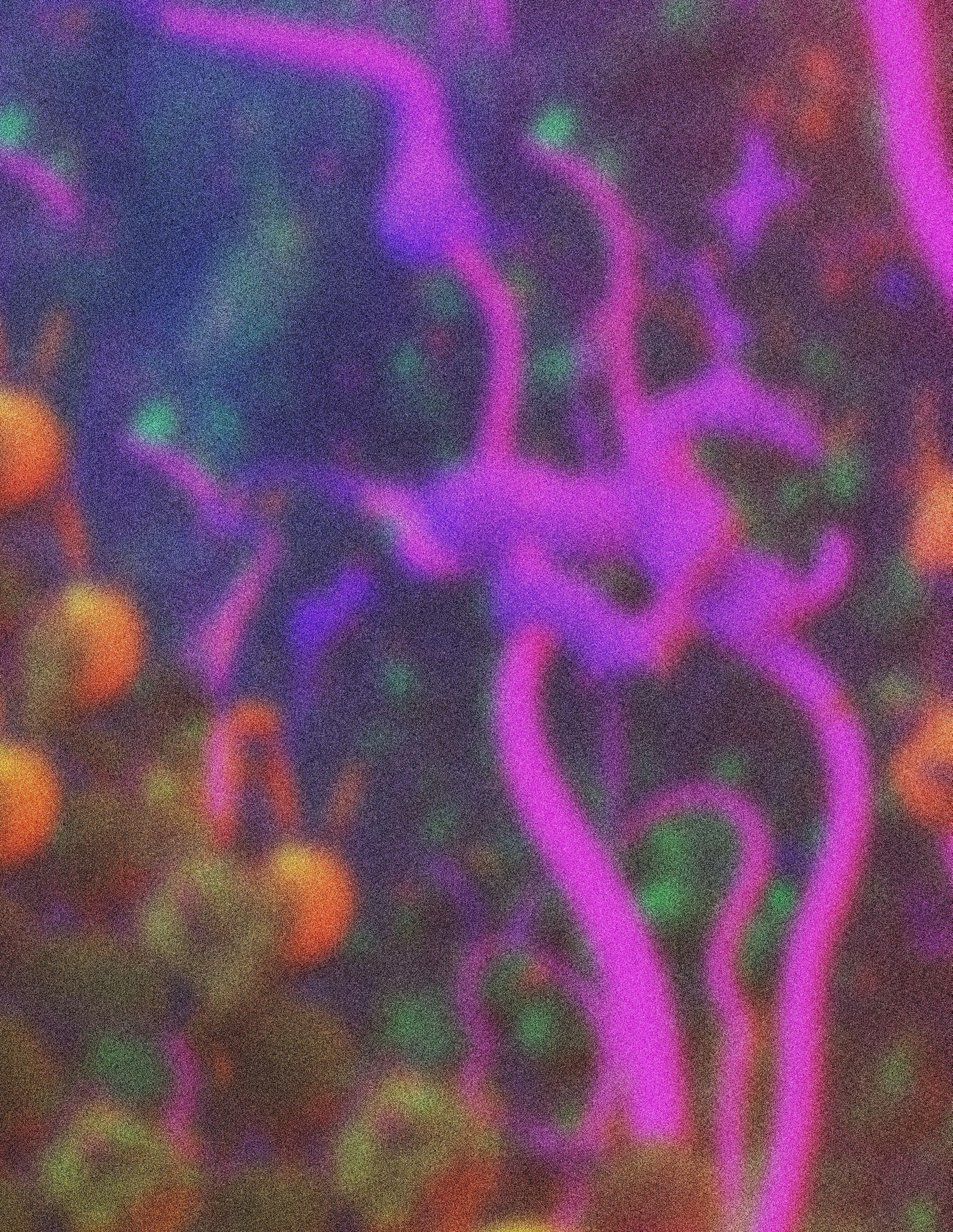
Creative Director
Lily Pecoriello
Art Directors
Sara Frankenthaler
Courtney Huang
Operations Director
Jasmine Peterson
Assistant Editor-in-Chief
Elena Egge
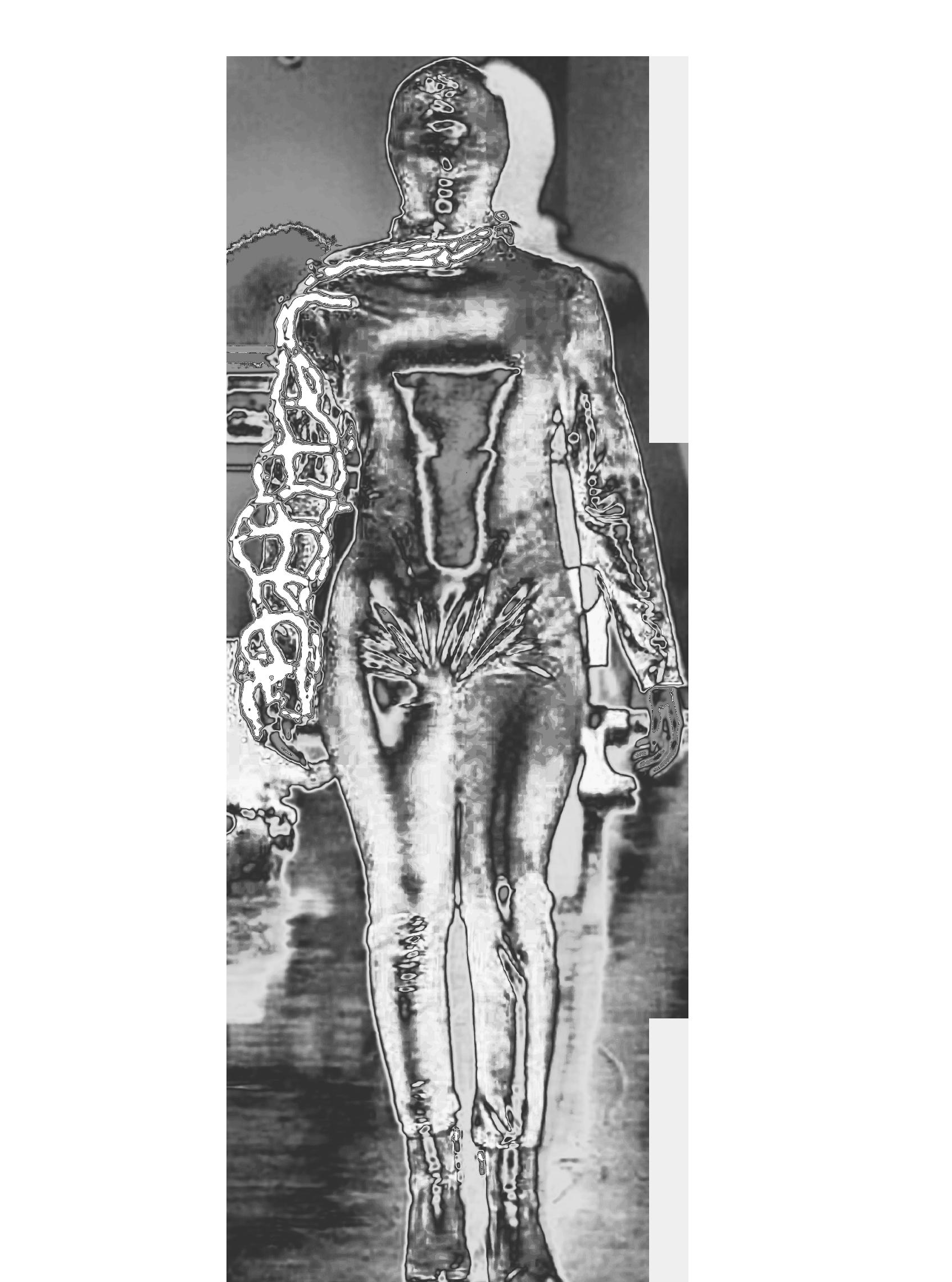
Bailey Herman
Assistant Creative Director
Trey Hepp
6
Shoot Directors
Ria Bakhaya
Tirza Elliott
Hannah Hollingsworth
Morgan Simers
Writing Directors
Brook Wang
Ellie Wells
Styling Director
Josie Zimmerman
Casting Director
Zoe Pessin
Event & PR Directors
Matteo Arshad
Nora Comas
Sophie Keyser
Lana Stenmark
PR Coordinators
Nicole Briceno
Ellie Budde
Gabby Guliants
Alicia Kang
Finance Directors
Miles Lieberman
Natalie Linares
Oliver Mass
Jon Oshinsky
Nico Scarpelli
Marketing Directors
Zoe Ademuyiwa
Phoebe Greenspan
Eli Ludden
Julie Song
Ethan Tsai
Sponsorship Coordinator
Emily Patchen
Instagram Directors
Violet deluca
Isabella BilousDiBucci
Harper Moothart
Angel Muyumba
Digital Design Director
Katie Zhu
Tik Tok Directors
Peyton Moore
Amaris Ninah
Nico Scarpelli
Videographers
Landon Highbloom
Alice Lee
Photographers
Rayna Auerbach
Anabelle Baum
Ella Dassin
Violet DeLuca
Trey Hepp
Bailey Herman
Courtney Huang
Ariana Kohl
Emily Lapidus
Bridget McGinn
Zoe Pessin
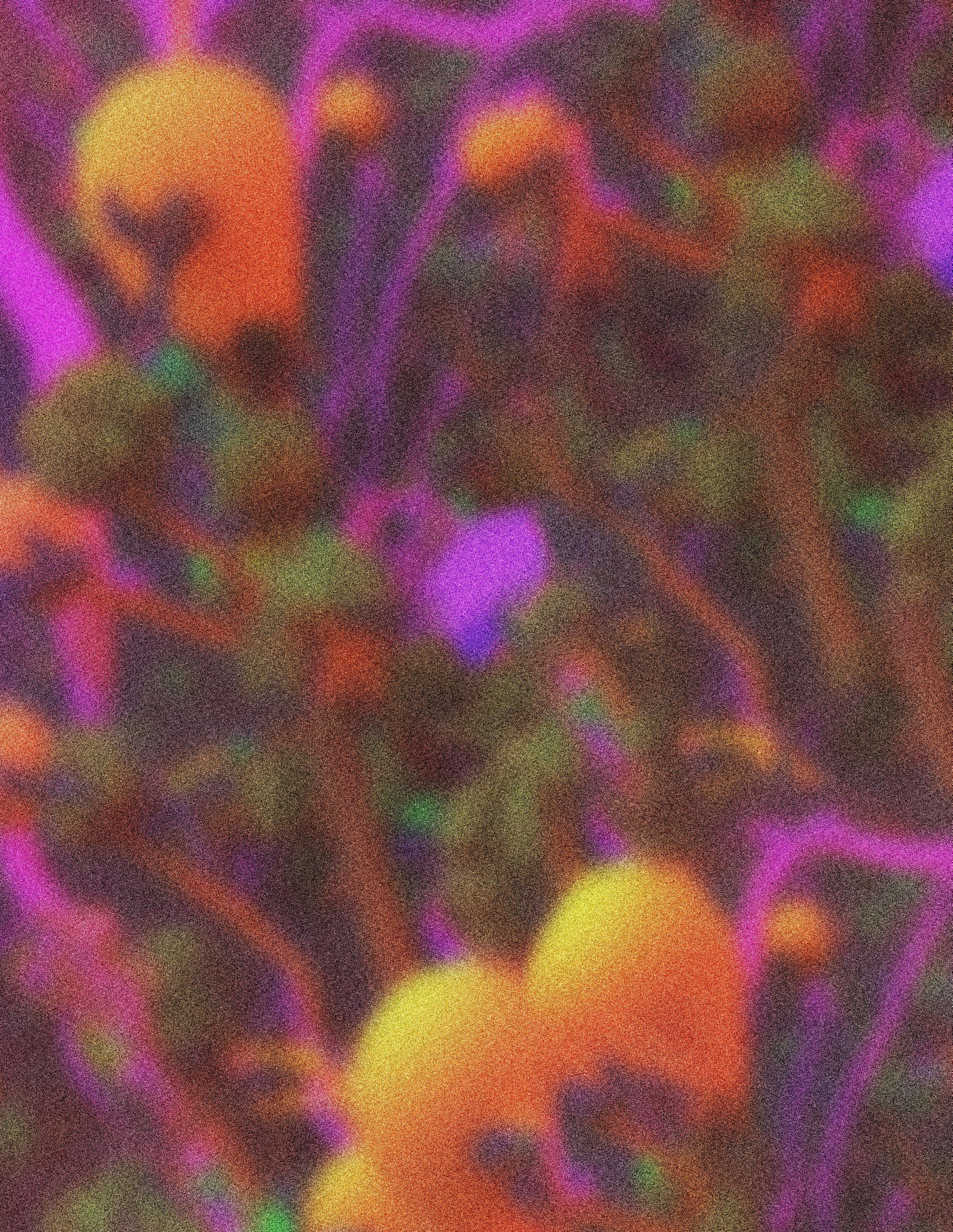
Stylists
Tenzing Dekyong
Harry DreesenHigginbotham
Estee Eidinger
Carmen Ganado
Jessie Kwon
Peyton Moore
Angel Muyumba
Brynne Vennemen
Jane White
Julia Yuan
Graphic Designers
Matt Grossman
Talie Johnson
Christine Jung
Clara Kim
Ariana Kohl
Hannah Leibovich
Abbey Rose
Chloe Wetzler
Katie Zhu
Writers
Riley Card
Natalie Chen
Tamara Dandreamatteo
Helen Ives
Ava Melton-Meaux
Harper Moothart
Jasmine Najari
Zach Trabitz
Talia Zakalik
Editors
Emily Bekesh
Rosie Swidler
HQ Representative
Jane White
Designers & Artists
Bei Qi
Maxine Roeder
Sarah Moon
Makeup
Sara Frankenthaler
Talie Johnson
Olivia Slemmer
Hair
Melissa Marks
Kyra Sorkin
Sourcing Director
Olivia Baba
Music Director
Ariel Grossman
7


Contents OTHER WORDLY ORGASM ANNA MOLINARI: MAKING FASHION INSTINCTUAL STAGES OF GRIEF WASH YOUR MOUTH APOCALYPSE ESSENTIALS RENAISSANCE 12 26 32 44 46 50 This is a sensory experience best enjoyed with the accompanyment of music. Scan here to listen. 8
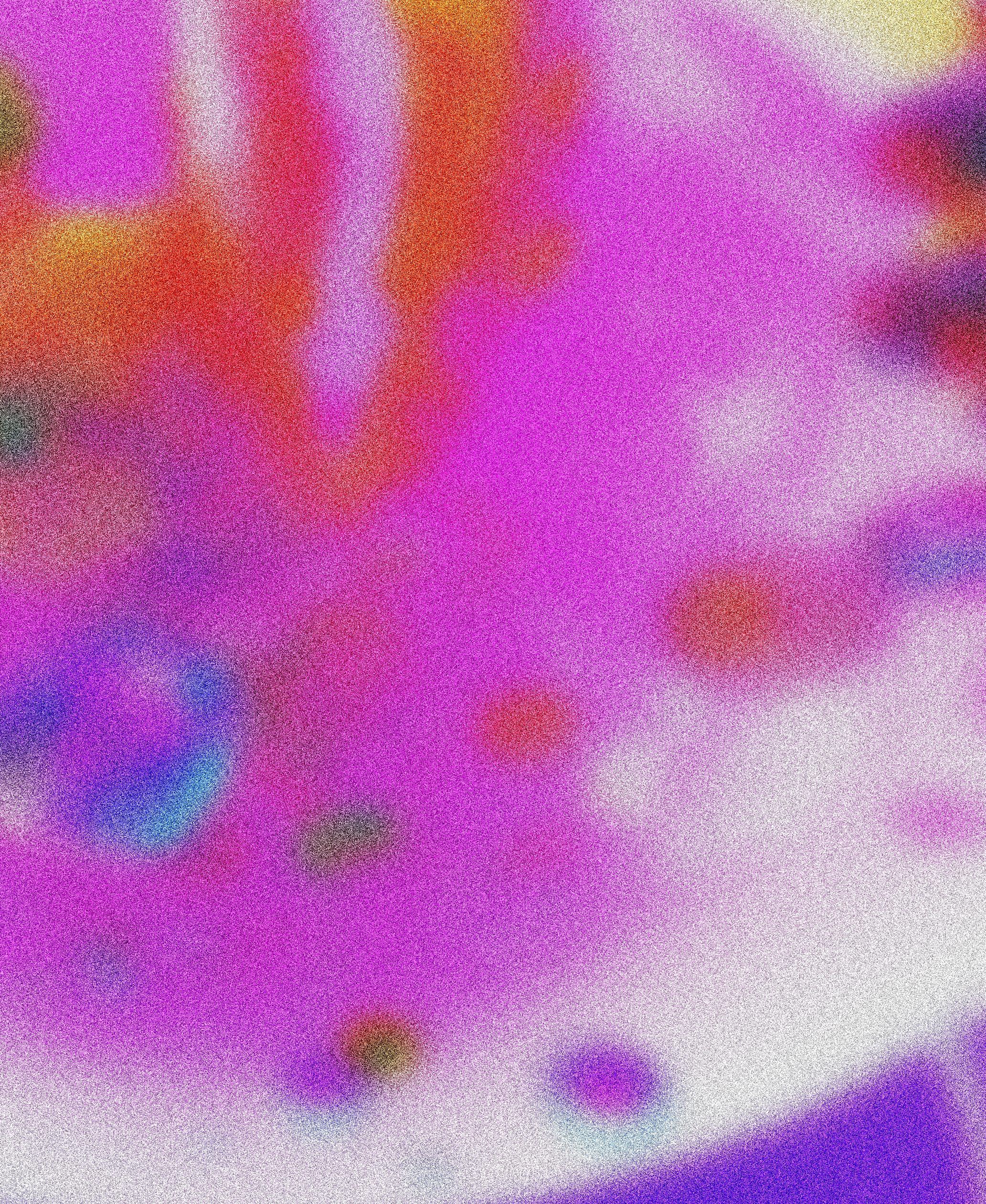


Directed by Morgan Simers
Writing by Brook Wang
Ellie Wells
Graphic Design
Sara Frankenthaler
Models
Sharon Chasin
Nigel Hendricks
Milo McFly
Alexa Schlau
Photography
Annabelle Baum

Violet DeLuca
Courtney Huang
Trey Hepp
Bridget Mcginn
12
Stylists

Jane White
Harry Dressen-Higginbothom
13
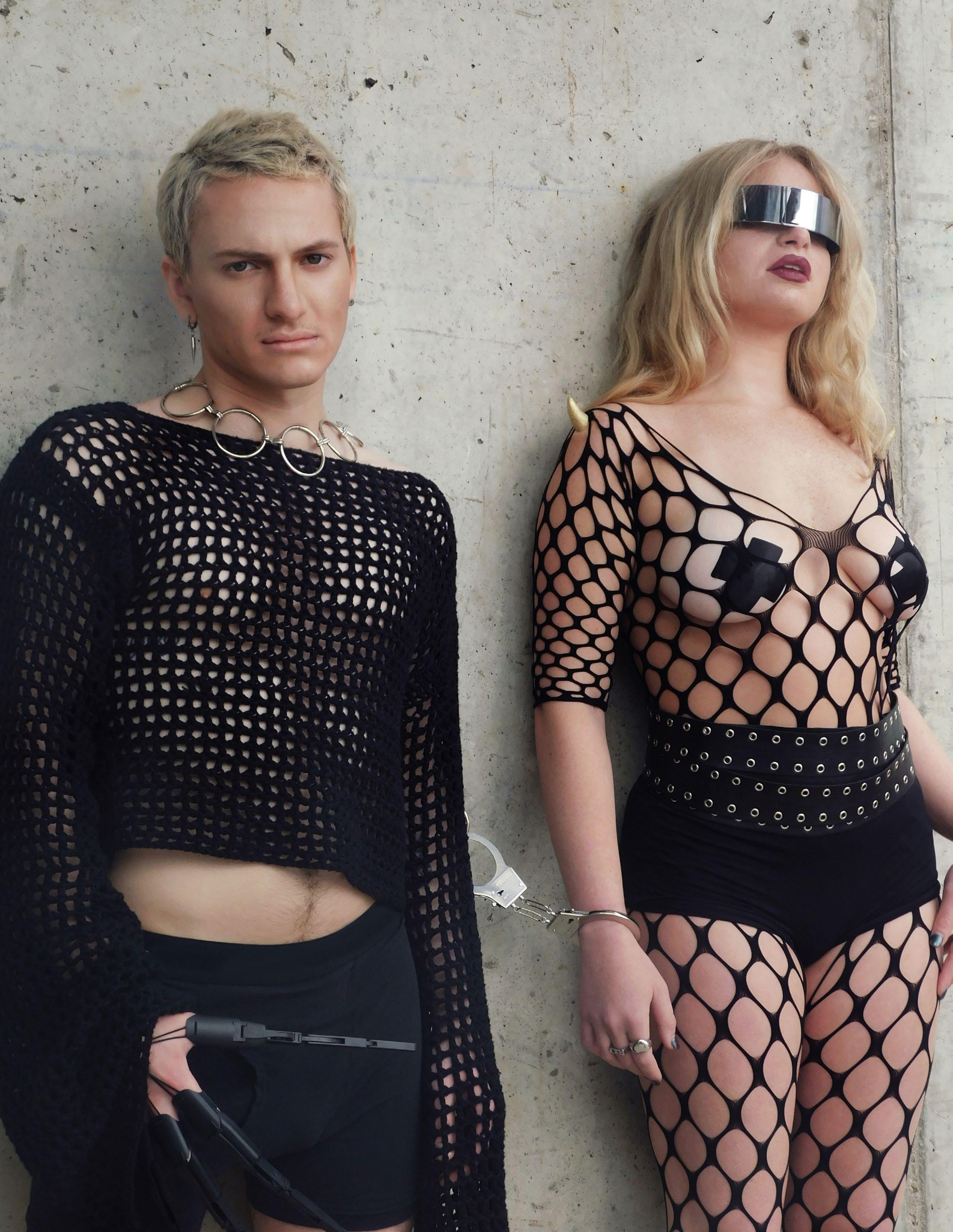

The space is empty but filled with noise — rhythmic moans of pleasure amongst grunts of pain. I close my eyes in bliss, my body nestled within an entanglement of arms, legs, tongues, teeth.

I feel a shudder between my lips and then the hot, milky liquid of pleasure down my throat. And while that indicates a conclusion, we are far from finished. Pleasure is infinite. All must be captured. In the haze, I bend and stretch my body. Anticipation buzzes in the air. I hope — yes. Toys have come into play; I am filled once more, the vibrations sending waves of heat through every nerve of my body until I am on fire.

elP a s urei s infi n ite. All m u s t eb utpac r e .d
16
Are we being loud? We must be; there are now too many hands that touch anywhere and mouths that lick everywhere to be four people. Time passes; I count the minutes through a kiss on my inner thigh, a bite on my nipple, and vibrations deep in my core.

The wave breaks, and I ride it until I see stars, until my body feels like liquid, until all I can do is lay on my back and stare up at the ceiling. I smile; I know that it is going to be a good day.
untilm y bod yfeels l i k e diuqil
The walk home after sex always feels different—the air more still, the lights softer, the voices sweeter. The world is calm, my chronic anxiety for now at bay.
17

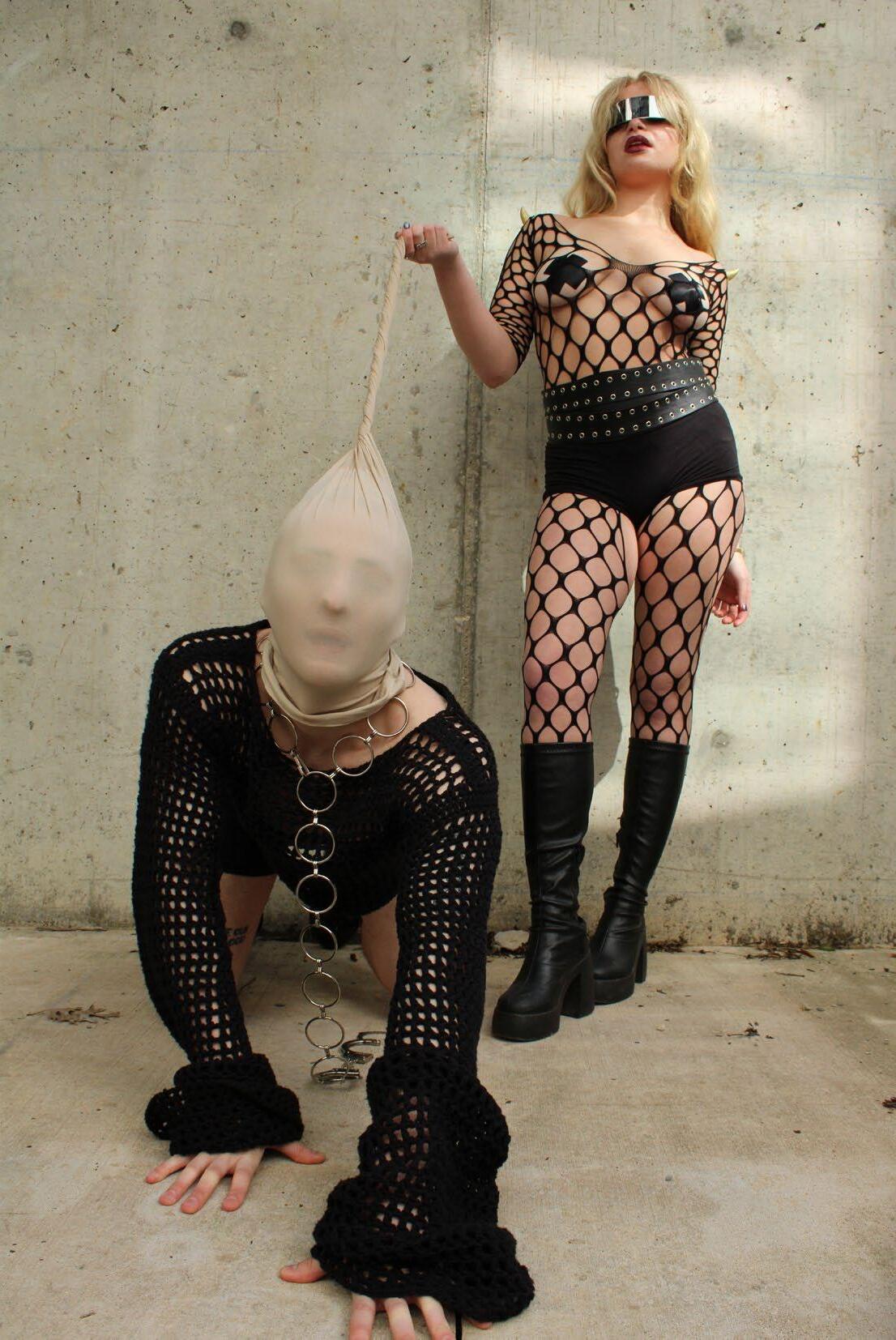


Scraps of metal glitter on the crumbling buildings, adding beauty to the destruction. It’s been nearly 30 years since the end of everything but we’re still rebuilding. I wasn’t born before the end, so the freedom and beauty of this world is all I’ve ever known. But I know stories from before; when I think of them, the walk home from sex feels sharply liberating.

People cared about a lot of things that fail to be important when the end of the world bursts onto the stage—what’s in your pants and how this dictates what you can wear, who you can sleep with, how you can behave, and what you get paid (though it was supposedly “equal”).
It didn’t dawn on me to care about my anatomy; not until I was in my 20s and sought out stories about the old world. That’s when I realized how “important” it could be, and how much more I should value the society
I live in now. I’ve read a lot about “gender”; we don’t have it here. I struggle to understand it if I am being honest. I’m attracted to everyone and to restrict my desires or shape my appearance based on “appropriate” people or patterns feels unnatural. I am still searching to understand who decided on all the appearance and behavior rules for bodies, but I have yet to come across the answer.
On the walk home I always gaze into streetlevel store windows because the reflection affirms a freedom I know I wouldn’t have in the old world. I love watching my hair catch on the breeze and expose the long chain earrings that loop and twist around my ears and down around my neck. The chains meld with my neck tattoos which deliberately highlight my firm jaw and manicured facial hair. My nipples push against the copper band that encases my torso as the slight wind prickles my skin.
20





I’m attrac t e d t o e v e r y o n e tI id d n ’ t da w n o n m e to care ab o u t my an a t omy



onallthe app e a r a n c e dna bhe a v ior rules rfo seidob
who de c i ded
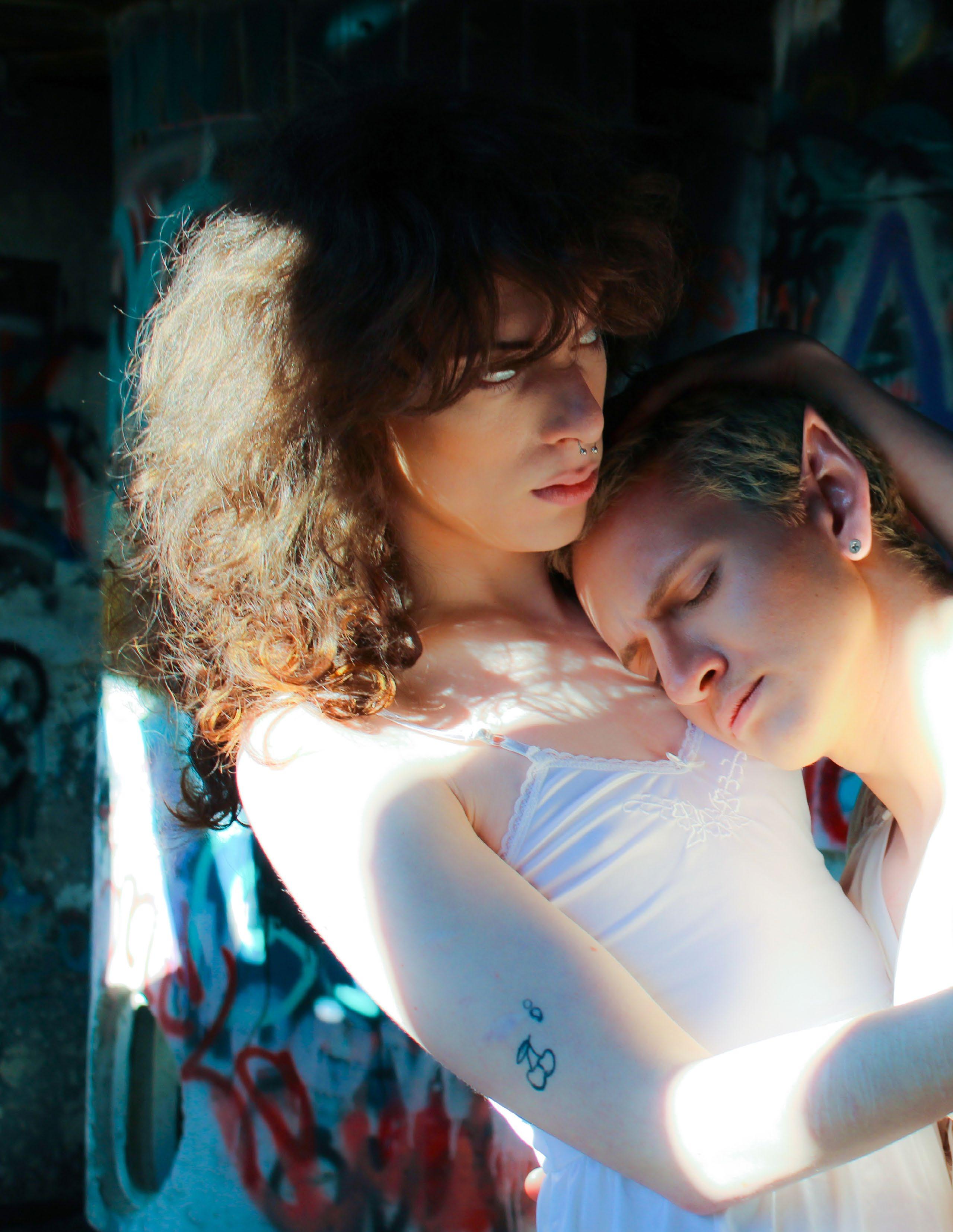
24
Across the street a flash of color catches my eye. Curls on curls of neon pink hair pile into an art piece and frame a particularly striking face. I can’t prevent a smile from forming— the toys in my pocket tingle as I remember an especially good morning of being buried beneath those curls. I think I may even have earned money for that lovely morning, but I can never be sure. Pleasure is pleasure.
I am thankful for this new world. I don’t exactly understand every way in which my life would be different 30 years ago, but I do know I wouldn’t want to look in the window reflections. I may have missed out on some of the old wonders—trees so tall they tickled the sky, blue waterfalls, lands of ice, mammals other than humans—but at least here I am free. We are free. Utopia.

h er e I a m f r ee . W e ar e f
25
.eer U .aipot

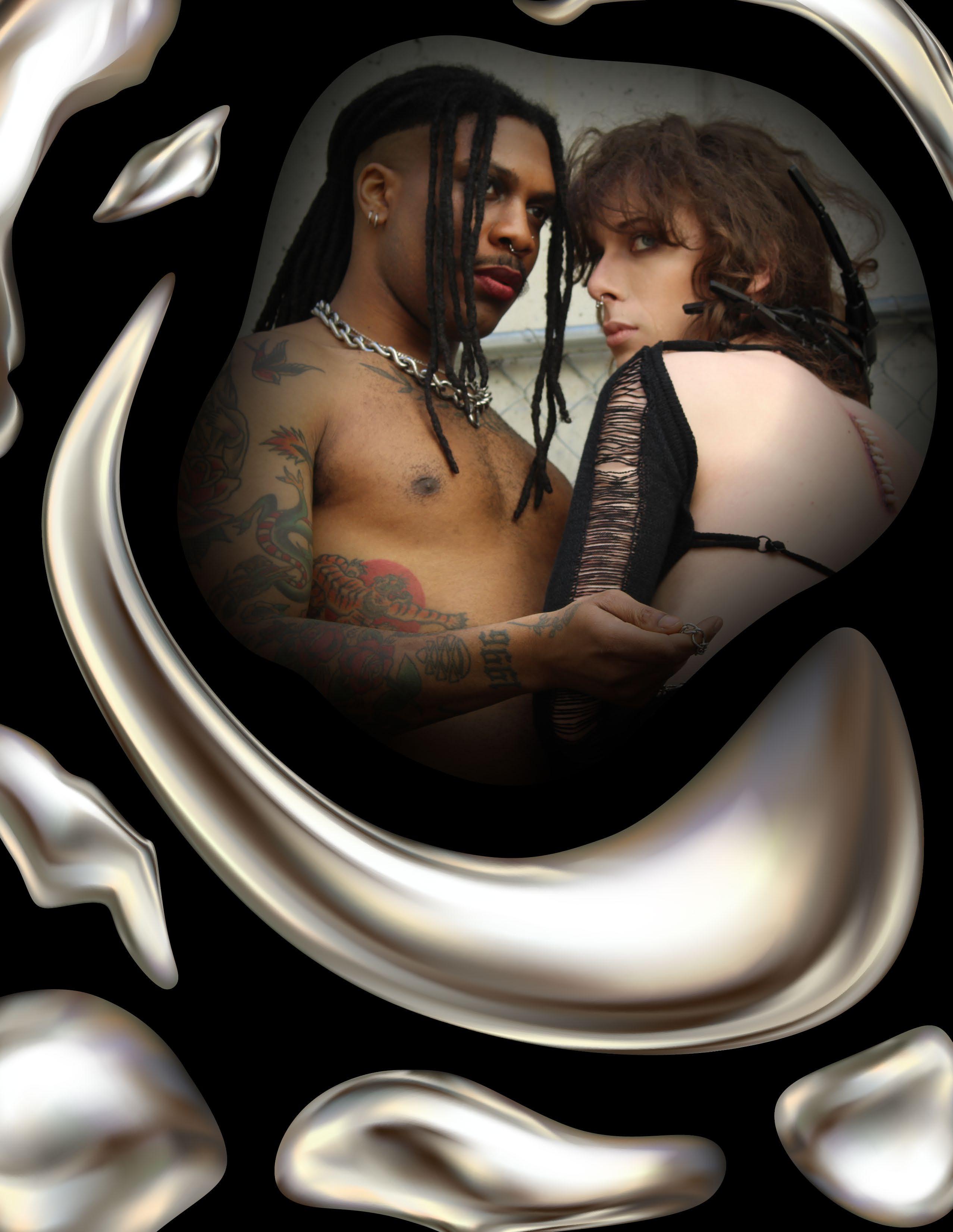
Anna Molinari: Making Sustainability Instinctual
 Interview by Jasmine Najari
Interview by Jasmine Najari
28
Designed by Sara Frankenthaler
How did you get started in the fashion industry?
I don’t remember a time when I didn’t want to be a fashion designer. I started making costumes for my winter musicals in high school and then I decided to study fashion design in college. Internships and jobs in college are when I started getting exposed to the real fashion industry.
How did you discover your passion for sustainability?
I grew up buying my clothes from thrift stores. Once I was in college, I started learning about how harmful the textile industry was through social media and my classes and that part of fashion was scary to me; I didn’t want to contribute to that. I also feel so inspired whenever I’m walking in the street and I see waste. Not in a weird way, I’m not like “Oh my god, fun, waste.” I mean that it inspires me to want to make change. During quarantine, I decided to dive deeper into sustainability, do my research, and make using sustainable materials my focus. I think that as a Gen-Z designer, it’s your duty to not contribute to textile pollution. There’s no reason to, especially now knowing what we know.
You recently started your brand Instinct which is focused on sustainability. Could you describe the process of creating your label?
I created my label in college. I was upcycling tailgate gear from old clothes and refashioning it or bleach ing it. And then this past year, I put out a fashion week collection and I decided that I need to make this brand official, so I filed to make it an LLC. Now, I’m launching a website at the end of the month where I will be selling my pieces.


How did you choose the name Instinct?
I made up that name way back in high school. Since my name is Anna Molinari people used to call me ‘animal,’ and when I was thinking about a brand name my mom was like, “What about Animal Instinct?” Once I got to college I was like, “No, I need to drop the Animal thing and I’ll just keep it to Instinct.” That fits really well with my brand because I think that if you are given the choice of something upcy cled or sustainable as opposed to something mass-produced, it should be instinctual that you choose the option that is better for the environ ment and the world.
How have you balanced creating your label and advocating for sustainability?
I think that my brand Instinct speaks for itself in that the clothes are primarily made from clearly recycled materials so they are a visual reminder to recycle and be sustainable. What I like about Instinct is that it’s clear what I’m doing. In the photos in my online store, each model has a plastic bag over their head to evoke an intense imagery of suffocation because that is what the fashion industry is doing to the environment. I think that having that niche of ‘trashion’ is what has made my social media career so successful and what will hopefully make my brand successful. When you have a really strong brand identity, it becomes a very powerful thing.
Is there anyone that you look up to in the fashion industry?
In the last few months, I have built a relationship with another designer named Peder Cho whose brand is called Utopia. I was on an upcycling TV show and he was a judge and then after the show, he DM’ed me and said, “Do you want to help me run my debut fashion week show and do you want to make a couple of pieces for it?” He basically brought me through the entire process of putting the show on, from start to finish. I was a part of every single phase –casting the models, doing the fittings, the actual show, alterations, all of that. So he has sort of become like a mentor to me and we have now a relationship going forward where I can go to him for advice and he can come to me if he needs an extra set of hands.
29
Recently Julia Fox has worn one of your looks. Could you describe the process of creating this piece, the inspiration behind it, and how it felt to see another icon wear one of your pieces?

I actually made that dress in college. It was the finale dress of my collection and I was graduating college in 2020 which, as we all know, is when COVID-19 started spreading, so my school and my fashion show got shut down. I thought that no one was ever going to get to see what I worked on. That collection with that dress is why I downloaded TikTok; that’s how I gained my following and that’s how Julia Fox noticed me. Basically, she saw one of my videos on TikTok, and she commented on it. I made a response video being like “Oh my god, Julia Fox just commented on my video. Do you want anything? I could make you this, I could make you this.’’ She followed me from that video and DM’ed me saying, “Hey girl, I would love to wear your art. Here’s my stylist’s address. You can send it or drop it off or whatever you want. What you do is beautiful.” I just felt like that dress she wore is such a full-circle piece; it had to be given to her.

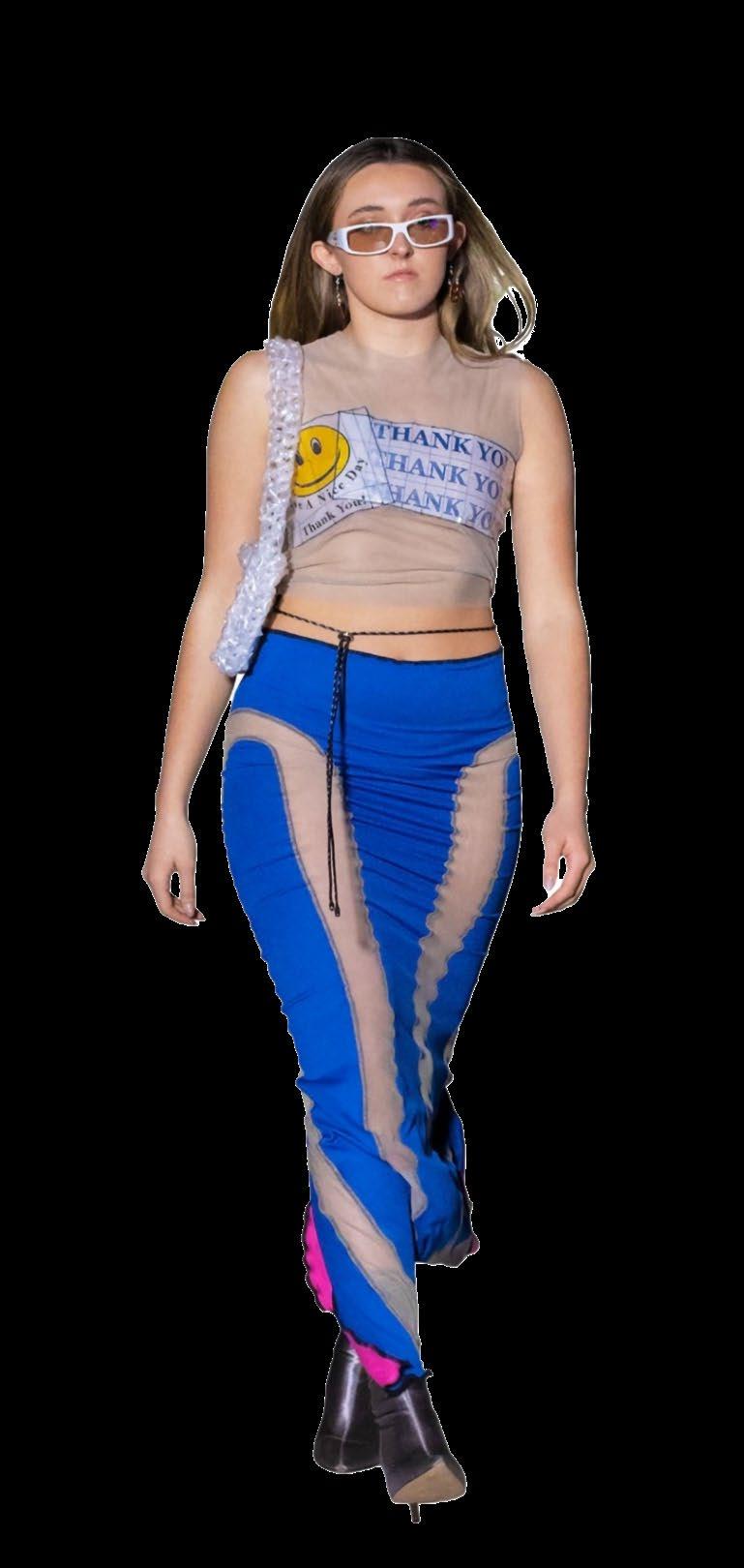
Throughout your career, what has been your favorite thing that you have designed?
I made a dress using newspapers from 2020 to 2021 which covered everything that happened in America—the good, the bad, and the ugly. At the time that I made it, the vaccine was starting to be distributed and I was scared that people had a mentality of “everything is going to be fixed now and we’re going to get back on track.” Meanwhile, there was so much that happened that requires change in this country; I wanted to put that in people’s faces and make it loud. That dress was really a labor
of love. It took me like two months to make. The reaction to that dress was just so touching and heartbreaking, but also meaningful at the same time. I had so many DM’s from people saying, “I lost my loved one to COVID and this dress really hits home for me and thank you so much for making this memorial.” People of color reached out and said, “This dress makes me feel heard.”
How would you define your role as a designer to spark social change in the sustainability movement?
That’s where the use of social media is important for me. Personally, I don’t see myself as an influencer. I like to think of myself as a designer and an activist, and I think that making these viral videos is really important because it spreads the message of what you can do with clothes. That is, what you can do with trash, how you can wear it, and all the ways to create sustainable fashion. I think that spreading awareness, showing visuals, and motivating people to make better choices are key to being a successful figure in the sustainability movement.
What is the responsibility of designers and consumers within the industry to do their research and to hold others accountable for the greater goal of achieving a more sustainable future?
I think the way to think about responsibility from both a designer and a fashion consumer perspective is that the world does not need new clothes. There are already hundreds and hundreds of pounds of old textiles and clothes in landfills, so the frame we need to look through is how can we do clothes in a new way? We need to rework the framework of the fashion industry. That’s where TikTok is not helpful because it can make something from Amazon go viral and then that item sells out, which is not healthy or helpful for the environment or anyone. It is also important as a consumer to search for small brands because often what consumers see on Shein or wherever else is a dupe, and the original product comes from a small brand. So if you find something that you’re obsessed with then try to find the original version. It’s like thinking before you speak: just think before you press the purchase button and try to be conscious of what you are doing.
30
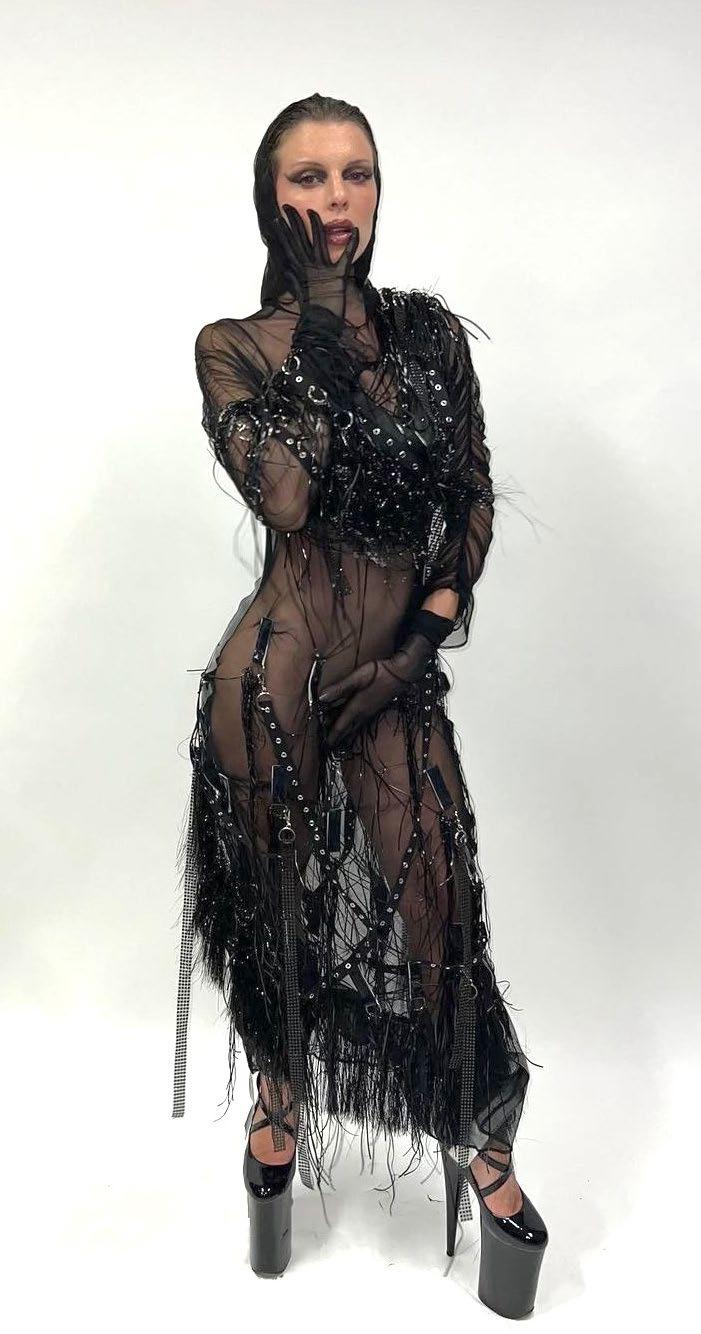
31

 Designs by Bei Qi
Designs by Bei Qi

“There’s this whole complicated and multifaceted process of grieving. I feel like a lot of people think about grieving as something surface level. It’s like anger, sadness, ‘this is your response’, but I realized it’s so much more complicated than that. It isn’t a straightforward process. Like although these are stages of grief, it’s not a linear process.”
“I wanted to conceptualize or visualize this pain that cannot be described using words.” – Bei Qi
Directed By Hannah Hollingsworth
Graphic Design
Courtney Huang
Hannah Leibovich
Models
Denial - Maddy Crawford
Anger - Samir Baumgartner-Joshi
Bargaining - Em Powers
Depression - Lillie Boero
Acceptance - Kavya Patel
Photographers
Ella Dassin
Bailey Herman
Trey Hepp
Courtney Huang
Bei Qi
34
Stages of Grief
Writing by Zach Trabitz
To better understand grief, I spoke with Megan Schaefer, Nationwide Children’s Hospital pediatric psychologist, and Bei Qi, the fashion designer for this spread. Interlaced with their interviews are pieces of writing relating to the grieving process.
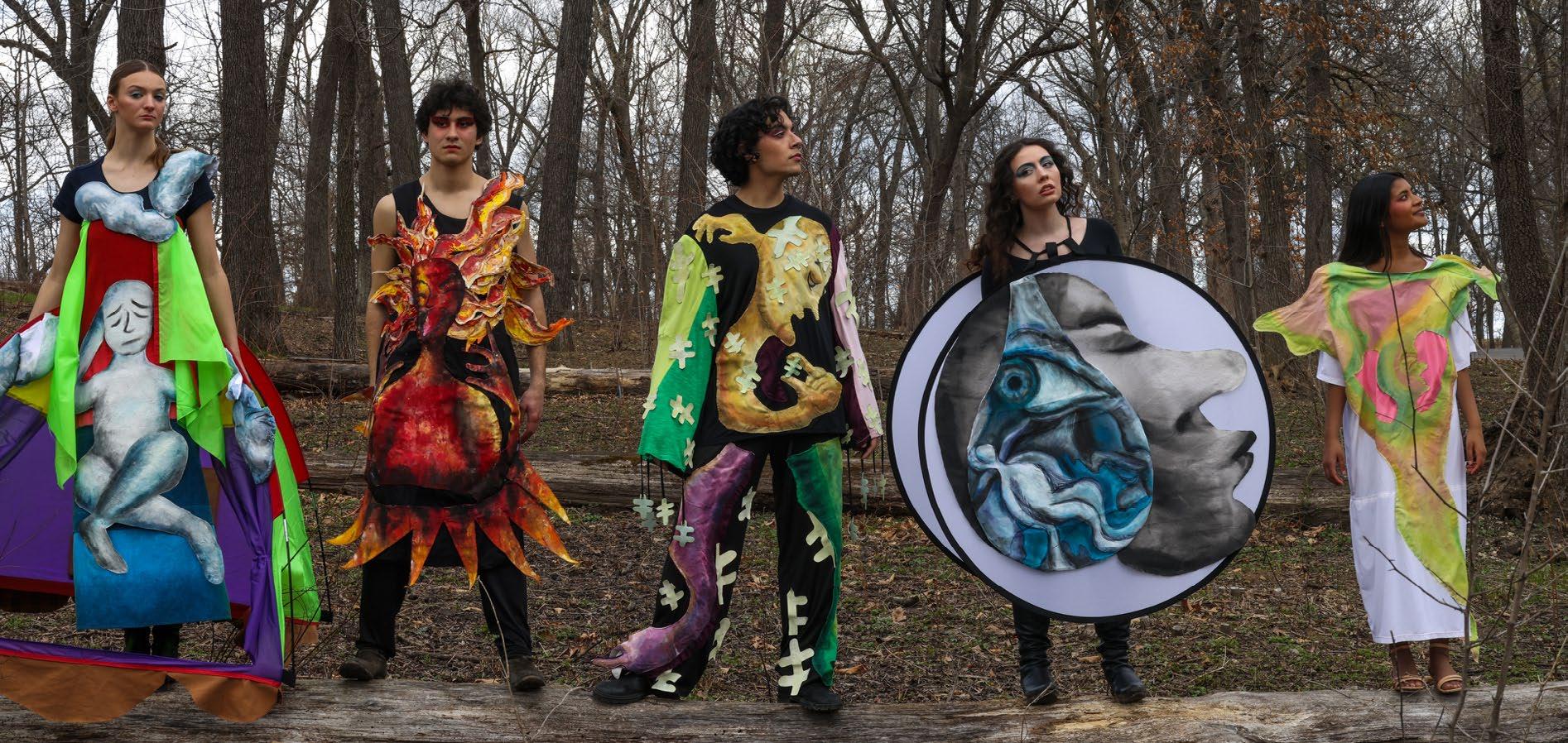
ounding the departed stays the same.
are lost, and opportunities slip away may

The manner in which people die, objects
is in turn derived from gravis, “heavy.”
Latin word, gravāre, “to burden,” which
change, but the gripping sadness surr35
The word “grieving” is derived from the
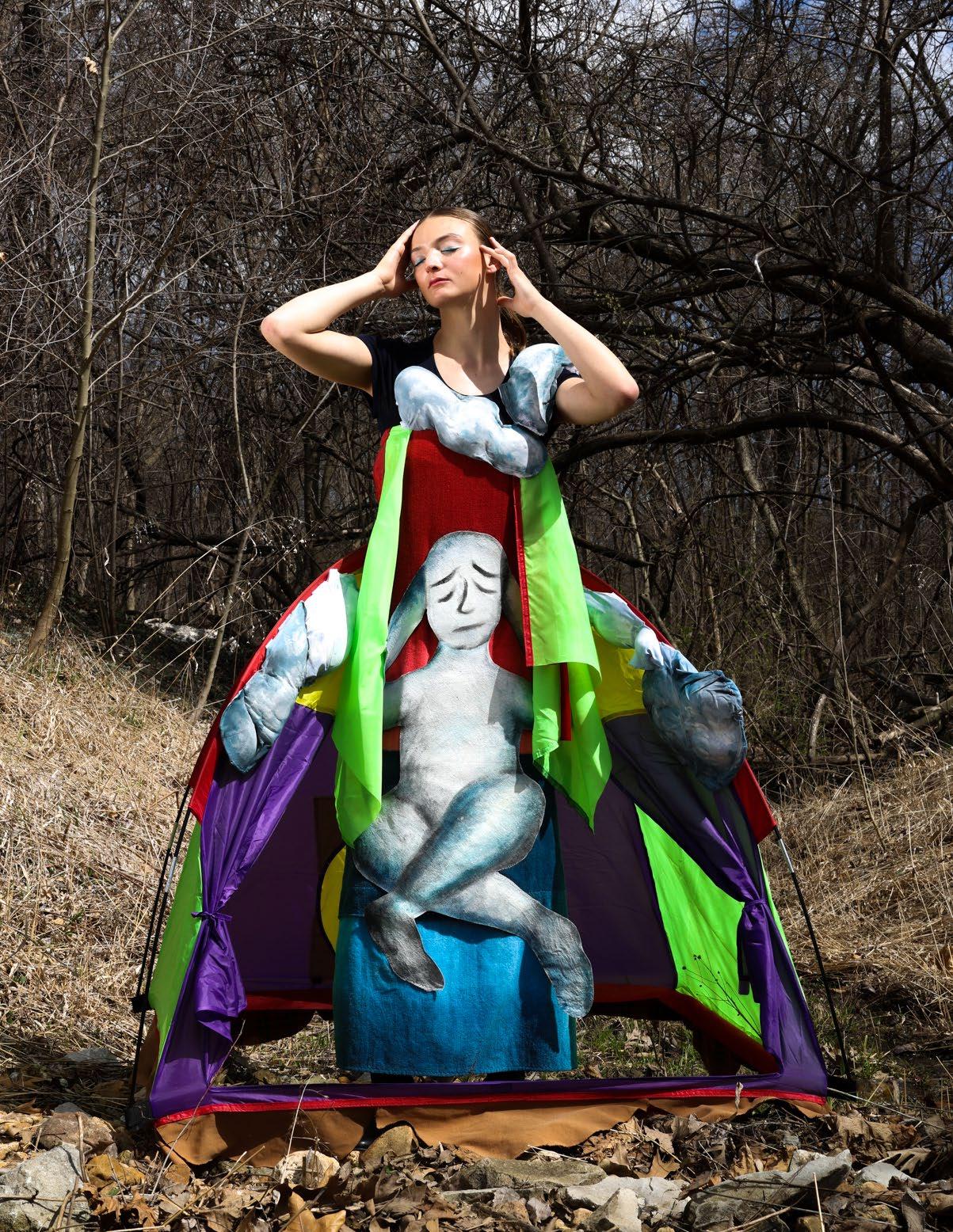

everybody will grieve at some point in their life.”
“I always say grief is normal. Everybody grieves,
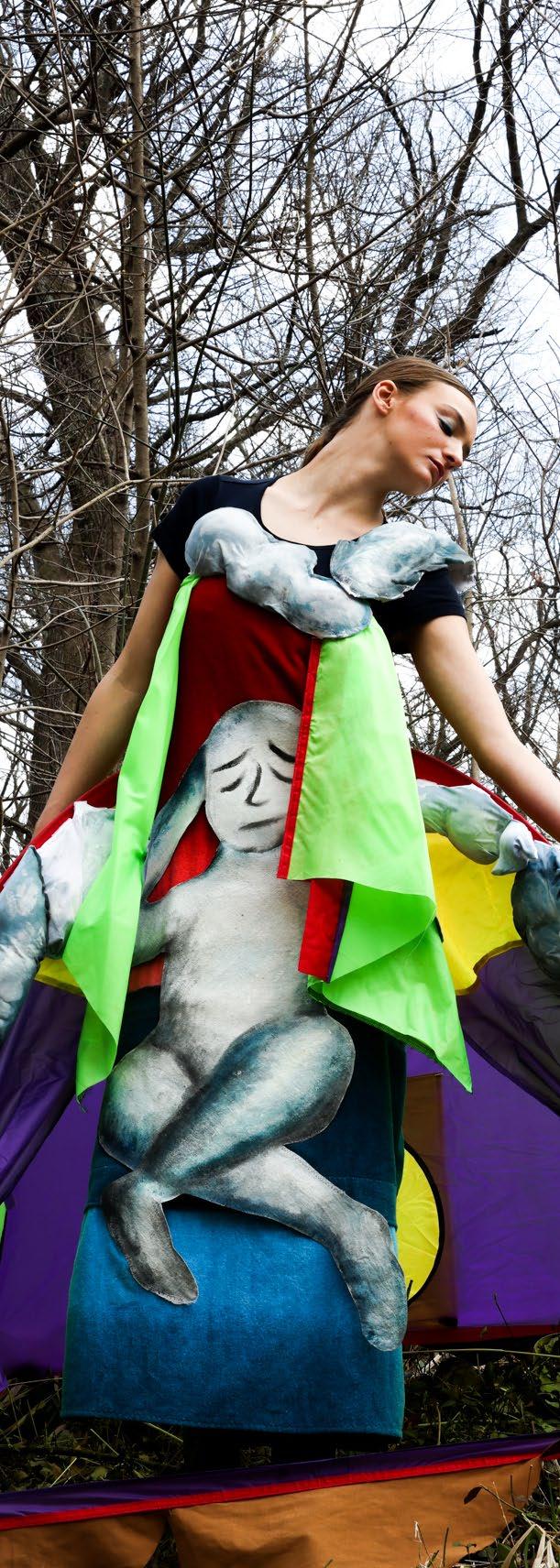
I just sleep. I just sleep. I don’t get up for anything. Please, let me go back to before. I refuse to feel. I lay still on a sunken couch.
Time passes, and I do not observe it. Please, just pass around me. Don’t involve me in this. Just leave me alone.
I want dust to turn to dust. Let the debris settle. I don’t want to be reminded anymore.
I rise only to collect everything that remains of you. What I can salvage. I ball my fists. But, this is not my reality. I refuse it to be.
I can’t, I don’t, think of the absence. I want it to not hurt. I want it to be gone.
So why doesn’t it leave? Why does it linger within me? It aches in every imaginable way. Please, just let me forget.
The inside of my head is frozen and numb, yet my face is red-hot with wet stains. I can’t even remember why I cried. There’s nothing to shed tears over.
Why do these tears keep falling, then?
ship with the individual.” –Megan Schaefer
person, or maybe they had a tense relation -
er they didn’t spend enough time with the
have some type of decisional regret. Wheth -
experience prolonged grief is usually if they
“But the risk factor for people who might
move forward.”
shock and denial. Like you’re not able to
“It can [cause] impairments in functioning:
01–Denial 37
Bad experiences are inherent to the human condition. Whether it is losing material objects or loved ones, loss is an inevitable part of life.
Grief manifests in many ways that are not exclusively internal—it can express itself through the body. These manifestations of grief through the body often culminate in anger, an all-too-common outlet of grief.


02–Anger
“From a physical standpoint, there’s research that shows that people who are grieving experienced physical changes in their body,” Schaefer said. “You’ve probably heard in newspaper stories, where, for example, the husband dies, and two days later the wife dies, right? Following extreme grief, there’s increased heart problems, difficulty breathing, or increased stress, for example, just various things that happen from a medical standpoint.”
“I think sometimes there’s guilt, sometimes there’s anger and frustration, of ‘why is this happening?’ A very common thing in grief is trying to make sense and understand why these things happen.”
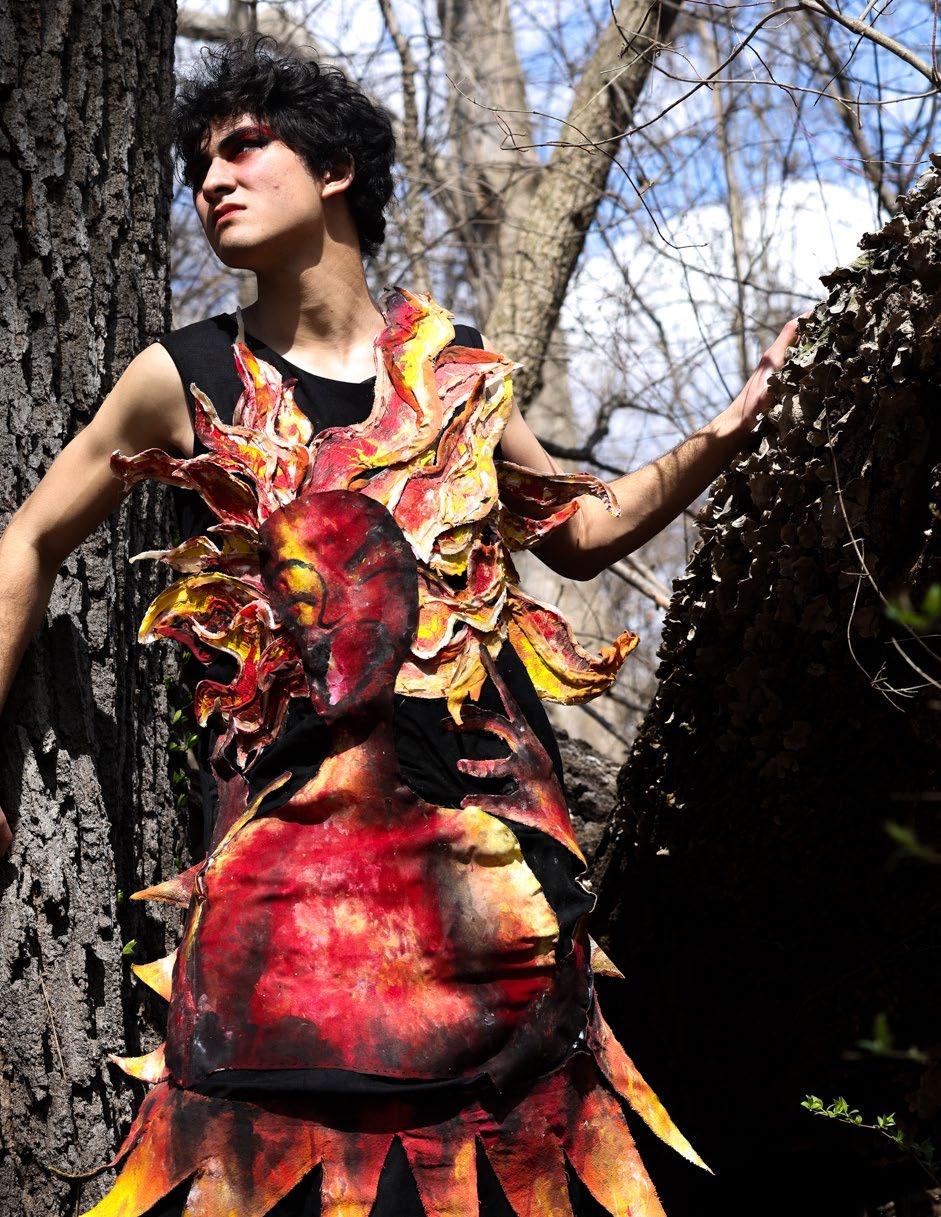 Schaefer
Schaefer
–Megan
“Ah shit, where are my keys?”

I stare at my door and glance up and down from the doorknob to my empty hand. Why did this have to happen now?
My shoes clack on the tile as I pace up and down the hallway. Why are they not in my bag? I feel like an idiot. I always forget these kinds of things, where could I have possibly left them? I’m going to have to get the locks changed now.
40
That’ll cost a ton, and I’m barely making rent right now as is. Fuck, why didn’t I clip them somewhere? I need to see what groceries I can scrounge together when I get inside. How am I even going to get inside? Do I call my landlord?
I probably forgot them somewhere at work today. Should I call someone who’s still there? No, everyone’s probably left by now. I should drive back. Wait, my car keys are also gone.
If I had been more on top of it at work today, this wouldn’t have happened. I’m always so clumsy with important things.
I should have a routine when I leave work. Why don’t I have a set routine? If I had actually tried more after on-boarding, I wouldn’t be in this situation. Why didn’t I try harder?
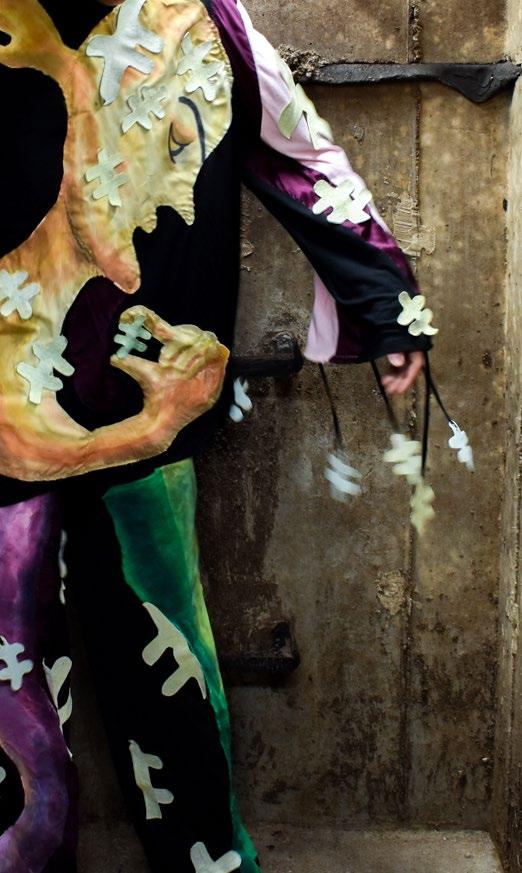

Why did this have to happen today? I’m such an idiot. Should I call my parents? No, they’ll have no sympathy for a mistake this stupid. If I had called them yesterday like I said I would’ve, maybe they’d have more sympathy. But at this point… I’m sure they’re out of patience.
But doesn’t this happen to everyone? What would an “average” person do now? What am I supposed to do?
Ah, wait. My back pocket—they’re here. Crisis averted.
03–Bargaining
I feel numb. I’m all in betweens. I’m limp, tugged along by the world in an attempt to care. I’m reminded by text, email, phone: you have to care. I just don’t.

Please, talk to me. Don’t leave me. I want to care. I need a tender touch. I miss the kindness. I need to care. I can’t just leave. But I want to leave. I need to tap out; I can’t do this.
It hurts here, it sears into me, in the heart.

I see morning glories bloom, warblers chirp and cheer, yet I only feel my crumbling body. My bed collects my own dust. There’s a constant low hum, my body feels scraped, it stings. I am paste and pulp all together.
I’m put under, with vines and webs and all coiled around me. Please, just leave me. It hurts to think.
My moving parts can’t come together.
Please, let me.
04–Depression 42

43
Grief can feel all-consuming and life-threatening, and society can be cold and uncaring towards it. Despite the stigma, Schaefer, who often works with parents who have lost children, views grief as something relieving; something that can bring joy.
“I feel that this work is really about celebrating the love and relationships families have with one another and finding ways that families can honor, celebrate, and remain connected with their child if they die.”

Grief intersects with many other cultural patterns and symbols, such as art. Designer Bei Qi incorporates how she processes and incorporates grief into her work.
“The way I process a lot of my emotions is through art, and so through art I get a lot of revelations that I don’t get in my everyday life,” Bei said. “I feel like by making these abstract pieces, I opened my mind to a lot of abstract emotions that I can’t even necessarily conceptualize with words.”
Along with more nebulous and artistic methods, psychologists use empirical coping mechanisms. For example, legacy-making, or the idea of leaving one’s mark on the world before they pass, is a central part of making grief more bearable for people who are dealing with the loss of a lovedone. Legacy-making is a way for people to begin to process and discuss death before it happens, which can help lessen the emotional toll it takes on families after the death. Schaefer listed examples, such as, “...writing letters to their family, or… gifting their favorite stuffed animal or just ways that they’re giving mementos to be remembered by people that they love.”
Grief is integral to the human condition. When coping with grief, one often feels deteriorated: emotionally, physically, socially. It stings, it hurts, it pierces through one’s mind and body. But, even though it is one of the most painful human emotions, beauty can come from it. Grief hurts. Loss hurts. It hurts. It hurts for a long, long time. But, eventually, it will pass.


05–Acceptance
Wash Your Mouth
by Riley Card
Illustrations by Abbey Rose Graphic Design Courtney Huang
The water hums with electricity. Crashing waves crackle with chemical reactions glowing green against the rocky shore. Her boot nestles into a pocket of igneous crumble and is quickly washed over by oceanic gunk. With her second step, she doesn’t make the same mistake; instead, her left foot deftly touches down on a crystalized saline core sticking out of the turf. The boots–made of Macro-sized Scorpion hide, the dominant predator of the year 2123–are a rich, inky black, like the charcoal of melted infrastructure. Sentimental trinkets from another life adorn the abrasive leather: a tear-shaped red rivet that used to be a metal heart pin, a navy nub from the butt of a child’s baseball bat.

And the mouthwash cap. Adrift at the end of the world.
It all started at her great, great grandma’s local pharmacy in 2023, in the aisle labeled “Oral Hygiene.” It was past the toothbrushes, the shiny Colgate ad, and the dental whitening strips. A blue bottle rested on that shelf–blue like aquamarine, blue like a melted Blue Raspberry snow cone from a tacky carnival stand. It was waiting on the shelf for her, pulsing with fate. This is the story of the cap on that blue mouthwash bottle.
The cap at the end of the world.
It was her great grandma who purchased this bottle of mouthwash. She had a nasty habit of stumbling home from the bar and passing out on top of the covers, teeth unbrushed. In 2023, dental hygiene was paramount, so the woman bought the mouthwash as a halfway solution—purification with minimal effort.
But the mouthwash–and the cap–sat. Unused, collecting pet dust mites on the marble vanity. Her sink was speckled with other purchased junk–white eyeliner used to paint her waterline, four claw clips that she snatched at random to reign in her curls, and earrings that looped like links of a chain con-
But the mouthwash sat.
necting handcuffs. She was a free spirit who loved crap of all shapes and sizes but particularly shiny junk that would wear well against her olive skin.
In 2024, she decided to throw one of those parties that usually left her sluggish and stumbling. To prepare her apartment, she threw out trash, trash that was destined to be trash from the minute she bought it, all shiny and new. She tossed the cap and container separately, then sprayed Cloud Eau de Parfume to reset. That night, she fell asleep entangled with an equally trashed lover, both foregoing clean teeth for immediate sleep.
Yet, there was something about that mouthwash cap. When the garbage man hauled the bag over his broad shoulder, it squeezed through the pursed lips of the plastic sack and jostled right out. It bounced and bobbled until it finally lay against the edge of a gutter on the Delmar Loop.
First it was seasons, then semesters, then years that passed away while the mouthwash cap waited. It was kicked by leather pumps, work boots, and partially-ashamed Uggs. Mardi Gras came and went with Jordans, kitten-heels, and wedged Tevas alike strutting the sidewalks. Here the cap layed, dirtied by exhaust, grease, and soiled melting snow. The cap stood witness to trends come and go, but never once did it experience a single person bend down and pick it up.
The cap was abandoned at the end of the world.
In 2031, the pace of life quickened. People had begun to lock their doors more tightly. There was talk of purchasing new storm windows for the local bar, Blueberry Hill, but the winds got so bad that the owners had no choice but to close shop. The quaking Earth, like a gargantuan stomach ache, shook the roads until Pitaya burst, littering the streets with imported bikinis—a bile of browns and greens and yellows. The cap churned in splintering asphalt, never cracking but squashing and bending with the tide of the rock.
For fifteen years, KN95s were back in fashion, made to match the colorful jumpsuits that protected human skin from radiation and chemical burns. Eventually, only the boldest left the house in them—or left the house at all—and only when food stores were so lacking that pre-teens cried in their parents’ laps and roommates haggled over the last can of refried beans. Resilience was the mantra of the 2050s, but the hollow tenet was no match for the hydrogen sulfide smothering, the fourth degree sunburns, or, worst of all, the red tide.
The red tide: a noxious phytoplankton that broke out over the Missouri River and shut down the water treatment plants of St. Louis. It spread to the Mississippi, turning everything red, red, red. Residents died of dehydration, until the sky erupted in rain. They danced in the puddles that splashed against their rainbow hazmat suits only to discover too late—this was acid rain. Tears of joy quickly smoldered into tears in heaven as citizens burned one by one.
And the mouthwash cap sat. Cynical at the end of the world.
It rained. And rained. And it didn’t stop. The empty streets flooded with swirling debris. The Mississippi and the Missouri rivers melded, littered with remnants from a world in limbo. A torn-up purple parka and cracked specialized eyewear
Here the cap layed, dirtied by exhaust, grease, and soiled melting snow.
46
for enduring blinding sun were dragged down in the rip tide. Natural gas seeped from underground reserves and lit fires, burning a warped blue over gushing streams.
The mouthwash cap bobbled along the churning rivers’ surfaces. It shot past the long sunken Cahokia mounds of Illinois, the tips of white oaks in Shawnee National Forest, the mounted church cross in Cape Girardeau, the Tennessee-Arkansas bridge wiring in Memphis, and the Walmart Supercenter in Vicksburg. In New Orleans, no one was left to greet the mouthwash cap with a low-cut velvet plush dress or a suit with a checkered pocket square. If humans survived, they were hiding. There was only open ocean now. Only solitude.

The cap sailed at the end of the world.
The pH rose and the acid rain sleeted. Soon, the mouthwash cap was no longer alone. It became a microcosm of a new form of life: whatever would endure. Microorganisms clung inside the cap like critters in Noah’s ark, a white boat of plastic glimmering unnaturally in the new world around it. It rained for forty years—sunny days, moon filled nights, and weeks with no light at all. From a hunky plastic saucer, the cap adapted just like the landscape around it. It burned low into a rigid-edged disk.
The cap mutated at the end of the world.
In the end, nuclear war was the last straw. A decisive victory—man over Mother—seemed to reset them both. The mouthwash cap was evidence, bathed as it was in the strange glow of Uranium cores. The cap grazed the legs of bioluminescent amphibians whose skin skipped a few million years of genetic splicing. And eventually, it was thrust upon a shore mutated by carbon-cover. It was hot, so damned hot-headed, this new Earth dreamed by its offspring. And it was dark, so dark under the smothering thunderclouds of ash.
Electric-charged water lapped the cap on the shore’s edge. A silhouette of a cellophane poncho momentarily shadowed it. A plastic claw hand seized the cap by the dip of its dimpled body and shoved it in a glimmering twine bag. Then, this woman scuffled away like a crab to her crag in the shoreline. If she wore white eyeliner and handcuff earrings, she would look like the mouthwash buyer all those decades ago.
This woman is a collector, one of the few to survive. Trash is just material meant to be re-imagined, re-purposed, re-cycled into a tool. Farces of the past are fashions of the future, of her future, her industrious insistence on living. Among her trash there is the tear-shaped red blob that used to be a metal heart pin, the navy nub from the butt of a child’s baseball bat, and of course, now, the mouthwash cap.
The cap that’s a button at the end of the world. A button of hope, a pin of rebirth, a token to remember that even when we are gone, life is not. Life persists. Plastic persists. Humanity? Evolves. With hope.
47
With hope, at the end of the world.
5 ESSENTIAL items to survive
the
APOCALYPSE in STYLE
2
Illustrations by
3
4
5
1
Writing Natalie Chen
Talie Johnson
Graphic Design
48
Courtney Huang
TO GENERATION Æ A-XII!

Trying to dress fashionably during the apocalypse may feel like a daunting task, but remember, “if you look good, you feel good!” We’re aiming to ~slay~ while attempting to survive. Put the muscles you’ve gained from all that self-defense to use and wade through the fashion graveyard of micro trends to find your next apocalyptic fit.

It can be difficult to know where to start. Maybe you can’t quite figure out how to carry your weapon of choice without looking bulky (no, that dagger does not make your butt look big), or maybe you deemed radioactive-green “not your color.”
We. Get. It. No need to fear because we’re here to guide you. We’ve curated a list of our recent must-have items for this season. Featuring an array of sensible fads and practical basics, these purchases will make you want to dress like there’s no tomorrow!
PRE-APOCALYPTIC PARACHUTE PANTS
If you’re anything like us, you probably already have a pair of these life-saving pants stashed somewhere in your backpack. But, if not, head over to your local clothing dump and we guarantee you’ll find some easily (the piles and piles of Shein are finally coming in clutch!). Those infinite pockets are perfect for all your apocalyptic supplies, and the naturally baggy silhouette means you can strap your larger weapons (and snacks) underneath while maintaining your chic look. Nunchucks, zombie repellent, pocket-sized solar-powered vibrator: the parachute pants have you covered!
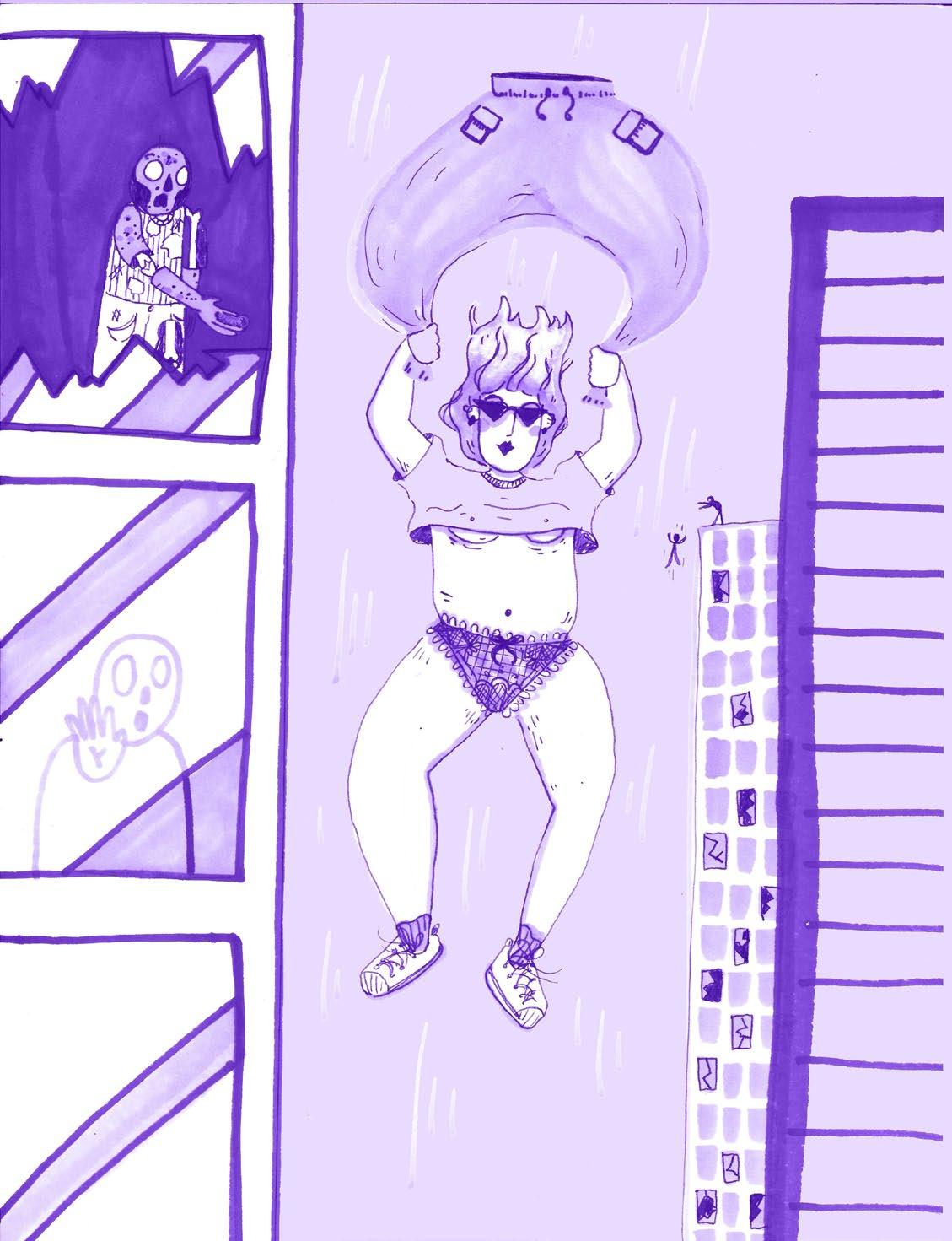
MADE WITH LIGHTWEIGHT MATERIAL!
WELCOME
1 49
20%NOWOFF!
THE BULLET BRA
Not only can the bullet bra give your chest a sexy, pointier look, but it’s also so apocalyptic-core. Invented during WWII to shield women’s nipples from the dangers of factory work, these bras are guaranteed to offer maximum protection. Plus, the pointy shape will give any member of the itty bitty titty committee a solid cup boost.

For an additional $9.99, you can even get your bra with an attachable frosting squirter. Katy Perry really taught us a lesson on the art of distraction back in 2010. Those idiot zombies will never see it coming…
CUSTOM FIT TO YOUR CUP SIZE
PUFFER PROTECTION
Michelin Man, move over! There’s a new puffy bitch in town. Not only does a puffer keep you from freezing to death during harsh winters, but it also protects your war-torn body from yet another apocalyptic injury. Plus, any puffer is an on-the-go sleeping bag, convenient for quick naps after long zombie-fighting battles. The walking dead will see you coming, but they will know you got major street cred.

3 4

ACCESSORIZE WITH SPIKES
SPIKE THEM ALL!
Watch out! Because this one is coming right off the runaway and it’s to die for. (Literally, customers have been breaking out in fights to get their hands on these.) Chokers, bracelets, belts, rings: SPIKE THEM ALL. Out of all the things we’re leaving in the past, a classic “emo” choker should not be one of them. Spikes elevate any outfit — especially if we’re talking spiked platform shoes. Plus, they’re practical in a pinch. Stylish self-defense is all the rage.
2
50
40% OFF SOLAR-POWERED VIBRATOR
After the UN decided to make sexual dissatisfaction a human rights violation, vibrators are everywhere. But this one is the best. And we promise we’re not biased (even though they’re currently 20% off using our promo code: MENCANFINALLYMAKEMECUM20). They’re portable — carry it in your pocket or wear it as a keychain — and, more importantly, solar-powered. This way, regardless of the frequent power outages, nothing can get in the way of your “me time.”
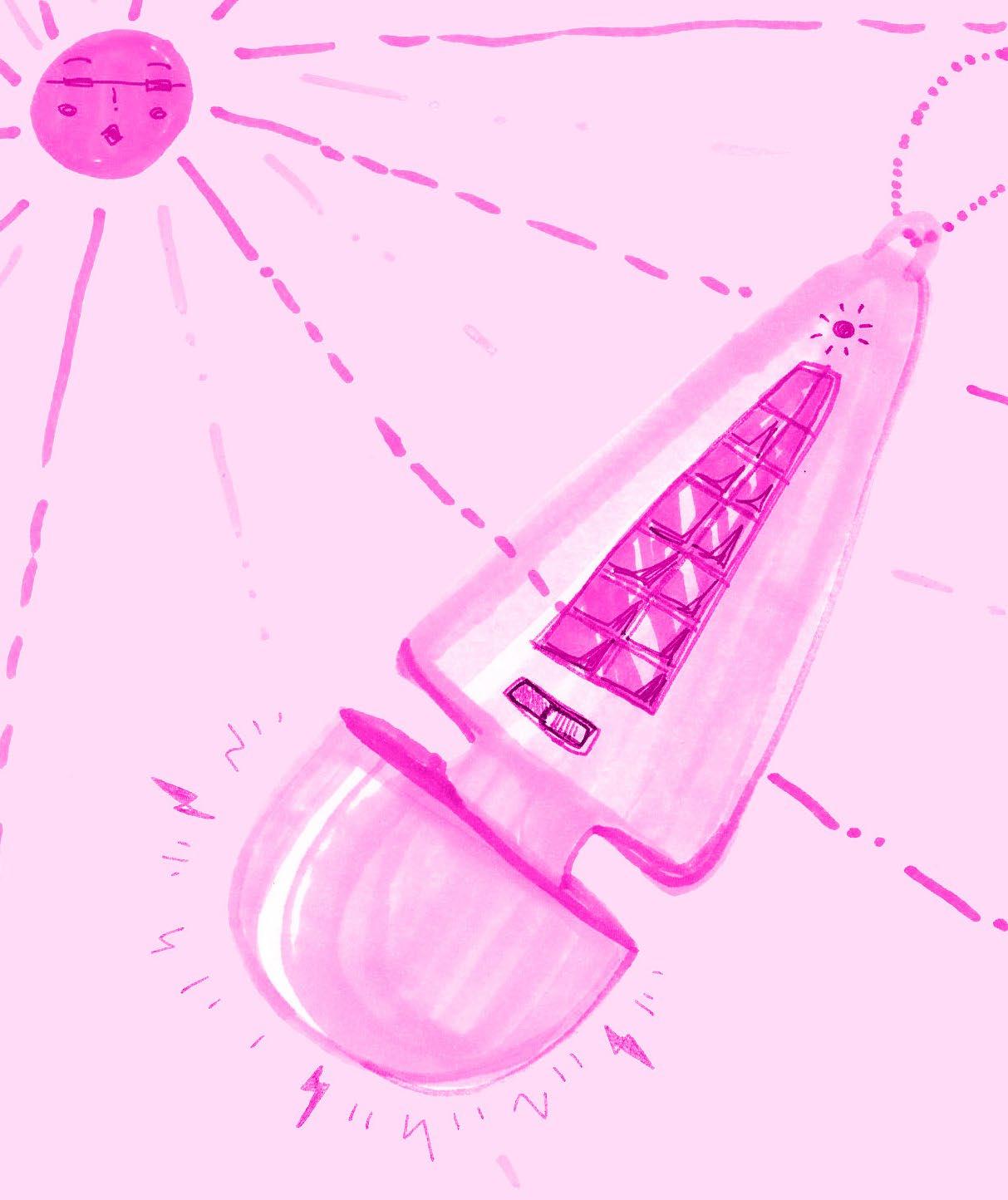
LASTS UP TO 24+ HOURS!
12 settings & 10+ colors to choose from!
Offer ends 5/30/3023
LIMITED TIME OFFER
51
Directed by
Tirza Elliott

Graphic Design
Courtney Huang
Clara Kim
RENAIS SANCE
Chloe Wetzler
Models
Angel Muyumba
Tenzing Dekyong
Audrey Langston
Photography

Trey Hepp
Courtney Huang
Zoe Pessin
Emily Lapidus
Bailey Herman
Stylists
Peyton Moore
Estee Eidenger
52


54


56

















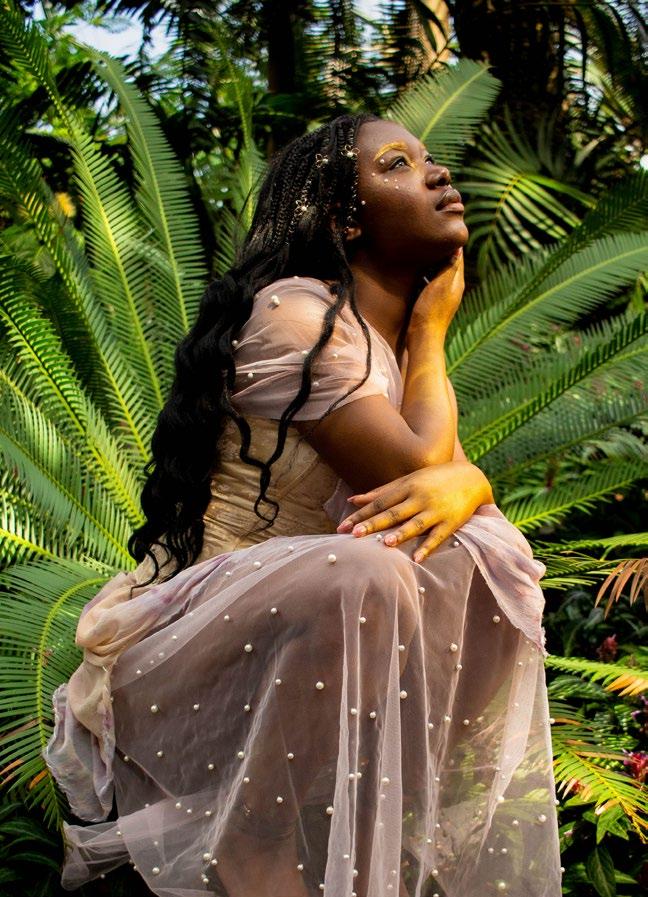
I didn 't realizeit , butmyeyeswere shutlong enough f o r e v e r y t h i n g t o c h a n g e . I d i d n ' t r e a l i z e i t , b u t m y ye se erew s otgnihtyreverofhguonegnoltuh .egnahc I ndid t' ezilaer ,ti erewseyeymtub hsltugno hguone f o r e v e r y t h i n g t o c h a n g e . I d i d n ' t r e a l i z e i t , b u t m y ey es were s hut long enoughforeverythingto change.



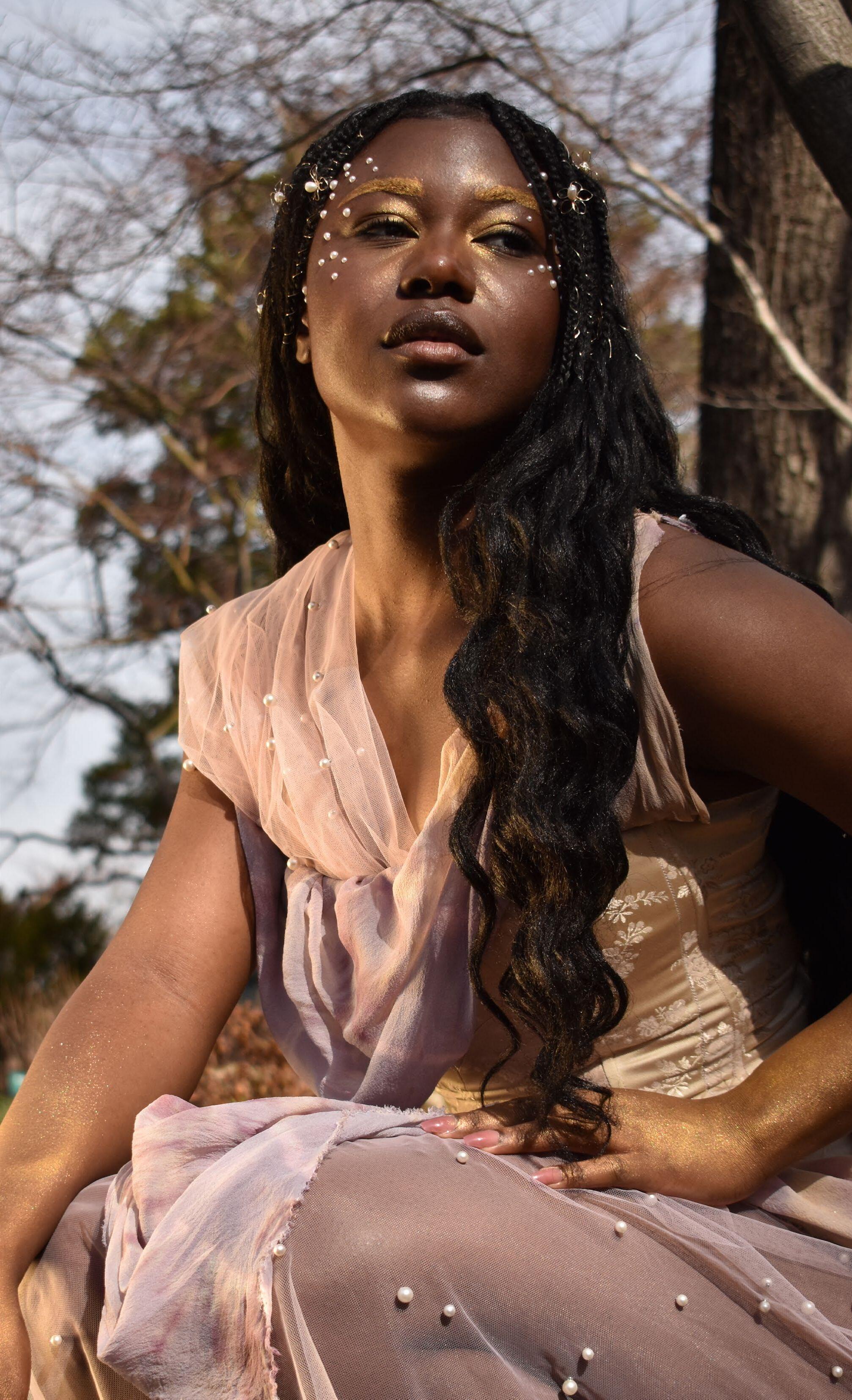
62
Mommy

told me to be
Iam
Mommytold me to b e brave . I a m b r a v e . M o m m y t o l d m e t o b e b r a v e . I a m .evarb ymmoM I.evarbebotemdlot .evarbma ymmoM dlot em ot eb .evarb evarbmaI . dlotymmoM em t o b e b ar v e . I a m b r a v e . M o m m y t o l d m e t o b e b r a v e. I am brave. Mommytoldmetobebrave. 63
brave.
brave.


65
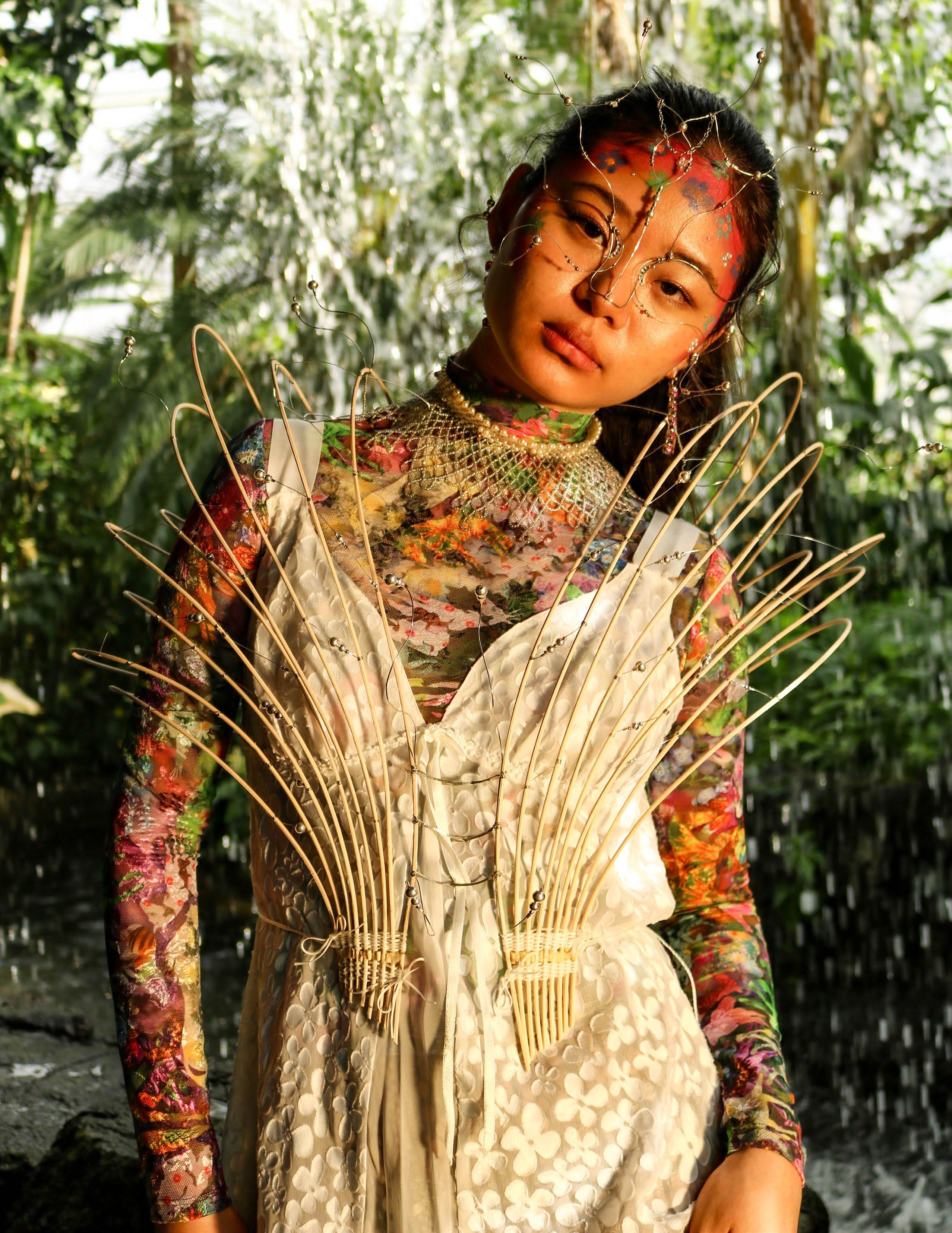


68

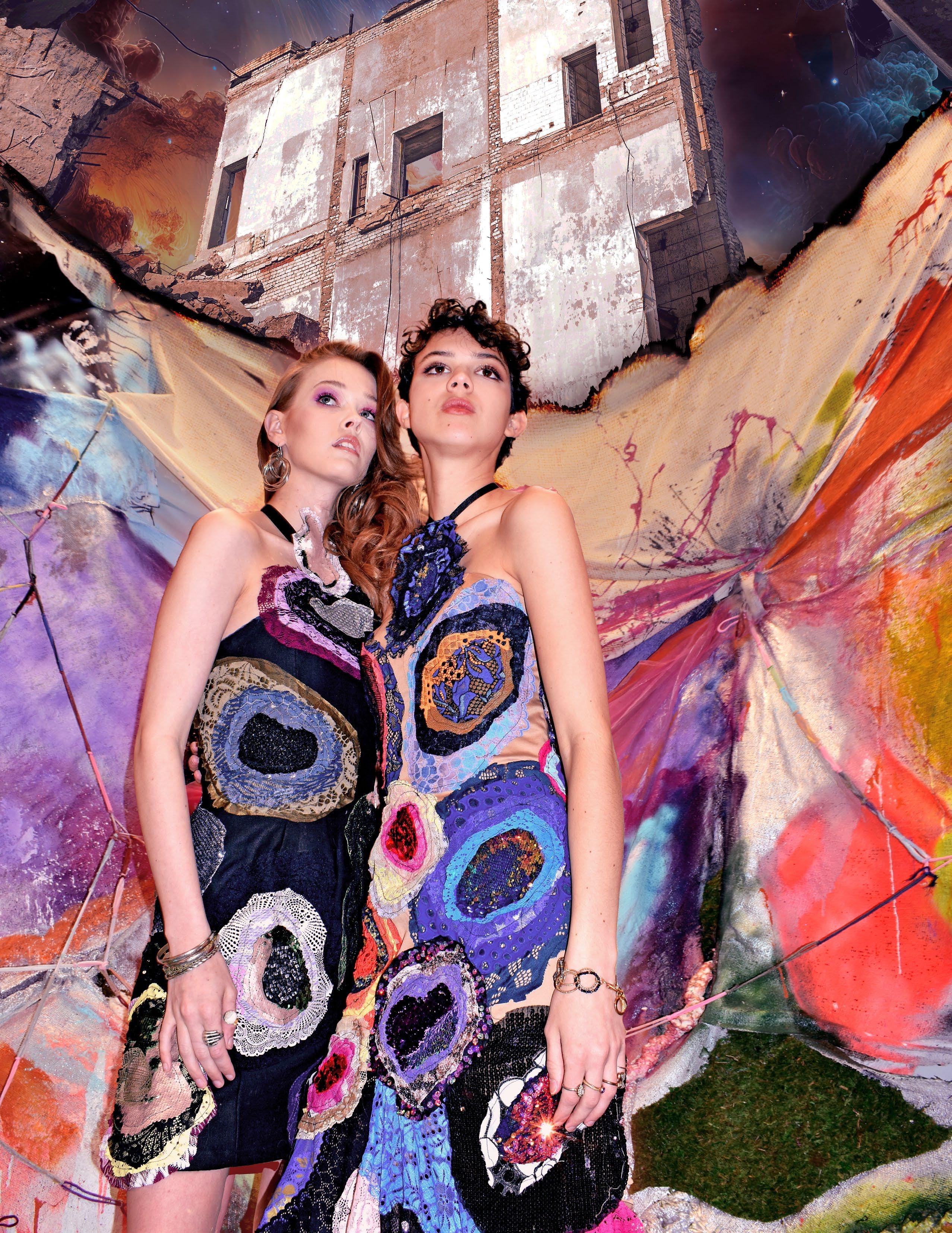
Oblivion
Directed by Ria Bakhaya
Photographers Rayna Auerbach, Trey Hepp, Bailey Herman, Courtney Huang, Ari Kohl
Styling Tenzing Dekyong, Angel Muyumba, Brynne Venneman, Julia Yuan
Pages 10-11
Model Christine Jung
Pages 32-33
Model Savan Cashman
Pages 70-71
Designs by Maxine Roeder
Models Emma Claisse, Violet Deardorff

71


























































 Interview by Jasmine Najari
Interview by Jasmine Najari







 Designs by Bei Qi
Designs by Bei Qi








 Schaefer
Schaefer























































